Catherine Curzon's Blog, page 22
December 14, 2016
Lady Anne Barnard
It's a pleasure to welcome Stephen Taylor, author of the fantastic, Defiance, to the salon. This wonderful biography of the estimable Anne Barnard, a most remarkable adventuress, is not to be missed!
---oOo---
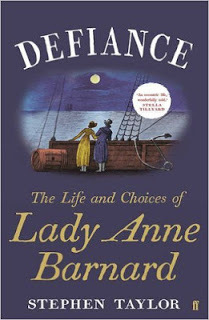 She lived vividly at the heart of Georgian society, wrote a ballad acclaimed by Scott and Wordsworth, was privy to one of the great secrets of the age and left a body of papers that bear comparison with those of Fanny Burney. So why is she better known today in South Africa than in her native land? As the biographer of Lady Anne Barnard, it is a question I puzzled over for years.
She lived vividly at the heart of Georgian society, wrote a ballad acclaimed by Scott and Wordsworth, was privy to one of the great secrets of the age and left a body of papers that bear comparison with those of Fanny Burney. So why is she better known today in South Africa than in her native land? As the biographer of Lady Anne Barnard, it is a question I puzzled over for years.
I knew when I started my research that the materials were rich. Anne’s years at the Cape of Good Hope from 1798 established her as one of those indomitable women travellers of the early empire, a free spirit who mixed as easily with indigenous Africans as with aristocratic proconsuls sailing to and from India. Her diaries, published in South Africa and pored over by historians, showed too that she was a brilliant writer and artist.
What I did not realise when I asked her descendants for access to her papers was how much broader the sweep of her pen had been. Rather than a starting point, the Cape had been a climax in Anne’s bewilderingly busy and adventurous life; and her chronicle of it – unpublished and virtually unseen – is a trove of fresh information and insights into the Georgian age.
But to go back to the starting point: why is she not better known?
The eldest child of the Fifth Earl of Balcarres, Anne Lindsay grew up in the brilliant milieu of the Scottish Enlightenment, sharpening her wits among the likes of David Hume and Adam Smith. James Boswell used to relate a story from their Scottish tour how this 23-year-old “lady of quality” could hold her own in exchanges with Samuel Johnson.
But hers was an age when the daughters of impecunious lairds were commonly married off to men of fortune, and from the outset Anne stood her ground against such a fate. She rejected at least eleven suitors, insisting that marriage must go with love. “Matrimony, I am not ready for thee!” she wrote. “To say Yes to a proposal that would thwart the heart as long as I existed? To cheat an honest man out of the only fortune he can expect to get with me, a free heart? No, I can’t”.
Her defiance of convention sat ill with Edinburgh’s pillars of rectitude. When Anne rejected the son of a judge, Lord Kames, he called her “a witch and a she-devil.” Attempting to turn a page, she fled to London.
Brilliance in company quickly established her as a figure in fashionable society. The Prince of Wales became a close friend and Anne introduced him to Maria Fitzherbert, the Catholic widow with whom he became infatuated. As his attentions intensified, Anne and Maria escaped to Europe, travelling together for almost a year before Maria’s resistance melted.
Meanwhile reputation started to catch up with Anne. To the cream of the social whirl, the haut ton, she was always an outsider. The respectable thought her eccentric – what a later era would have termed bohemian – because she lived independently, buying, decorating and renting houses in fashionable locations like Berkeley Square.
There were also scandals. London loved gossip and though Lady Anne Lindsay never gained the notoriety of Frances Villiers or Mary Coke, her love affairs attracted a good deal of attention. An incident involving a dissipated wastrel, Lord Wentworth, led to Anne being dubbed “the Devil in Scarlet” by Lord Byron’s mother-in-law. In the course of another doomed liaison, with the politician William Windham, she travelled to France to observe the Revolution.
These episodes left scars. As became clear when I discovered her papers, it was Anne’s sensitivity about her past that resolved her, in effect, to blot out her story.
The prospect that she would marry appeared to have passed when she received what was her thirteenth proposal at the age of 42. Andrew Barnard, a handsome but unknown former army officer, was 30. She accepted, and began the biggest adventure of her life.
Together they sailed to the Cape where she had obtained him the post of secretary to the governor. The Barnards lived in a simple cottage called Paradise at the foot of Table Mountain where she kept a small menagerie of wildlife. At the same time she acted as the governor’s hostess.
For this land, which they both came to love, she had a wider vision. When the Barnards set off on a wagon tour of the interior, Pitt’s government saw the Cape as no more than a strategic bastion to protect its vital shipping network to India from the French. Anne did her best to convince influential friends at home that Africa too had potential. “Here is scarcity, but here will be plenty,” she wrote to Pitt’s deputy, Henry Dundas. “It is in the power of activity to make this the finest scene in the world by planting.”
Andrew Barnard died at the Cape. It is clear from their letters that the marriage had been supremely happy and nothing could replace him in her life. Anne lived at Berkeley Square until her death aged 74 in 1825, devoting her final years to the creation of six volumes of memoirs in which she recorded her life with wit and irony, along with a searing honesty. Hence the edict she issued shortly before her death that they were for the eyes of family only and never to be published.
When writing to the Earl of Crawford and Balcarres, custodian of the memoirs, I had no idea of their scope and content. As it transpired, they opened the door to exhilarating and ever more astonishing places. Anne kept me fascinated, and had surprises in store right to the end. So for the reader too, I hope, will Defiance: The Life and Choices of Lady Anne Barnard.
---oOo---
 She lived vividly at the heart of Georgian society, wrote a ballad acclaimed by Scott and Wordsworth, was privy to one of the great secrets of the age and left a body of papers that bear comparison with those of Fanny Burney. So why is she better known today in South Africa than in her native land? As the biographer of Lady Anne Barnard, it is a question I puzzled over for years.
She lived vividly at the heart of Georgian society, wrote a ballad acclaimed by Scott and Wordsworth, was privy to one of the great secrets of the age and left a body of papers that bear comparison with those of Fanny Burney. So why is she better known today in South Africa than in her native land? As the biographer of Lady Anne Barnard, it is a question I puzzled over for years.I knew when I started my research that the materials were rich. Anne’s years at the Cape of Good Hope from 1798 established her as one of those indomitable women travellers of the early empire, a free spirit who mixed as easily with indigenous Africans as with aristocratic proconsuls sailing to and from India. Her diaries, published in South Africa and pored over by historians, showed too that she was a brilliant writer and artist.
What I did not realise when I asked her descendants for access to her papers was how much broader the sweep of her pen had been. Rather than a starting point, the Cape had been a climax in Anne’s bewilderingly busy and adventurous life; and her chronicle of it – unpublished and virtually unseen – is a trove of fresh information and insights into the Georgian age.
But to go back to the starting point: why is she not better known?
The eldest child of the Fifth Earl of Balcarres, Anne Lindsay grew up in the brilliant milieu of the Scottish Enlightenment, sharpening her wits among the likes of David Hume and Adam Smith. James Boswell used to relate a story from their Scottish tour how this 23-year-old “lady of quality” could hold her own in exchanges with Samuel Johnson.
But hers was an age when the daughters of impecunious lairds were commonly married off to men of fortune, and from the outset Anne stood her ground against such a fate. She rejected at least eleven suitors, insisting that marriage must go with love. “Matrimony, I am not ready for thee!” she wrote. “To say Yes to a proposal that would thwart the heart as long as I existed? To cheat an honest man out of the only fortune he can expect to get with me, a free heart? No, I can’t”.
Her defiance of convention sat ill with Edinburgh’s pillars of rectitude. When Anne rejected the son of a judge, Lord Kames, he called her “a witch and a she-devil.” Attempting to turn a page, she fled to London.
Brilliance in company quickly established her as a figure in fashionable society. The Prince of Wales became a close friend and Anne introduced him to Maria Fitzherbert, the Catholic widow with whom he became infatuated. As his attentions intensified, Anne and Maria escaped to Europe, travelling together for almost a year before Maria’s resistance melted.
Meanwhile reputation started to catch up with Anne. To the cream of the social whirl, the haut ton, she was always an outsider. The respectable thought her eccentric – what a later era would have termed bohemian – because she lived independently, buying, decorating and renting houses in fashionable locations like Berkeley Square.
There were also scandals. London loved gossip and though Lady Anne Lindsay never gained the notoriety of Frances Villiers or Mary Coke, her love affairs attracted a good deal of attention. An incident involving a dissipated wastrel, Lord Wentworth, led to Anne being dubbed “the Devil in Scarlet” by Lord Byron’s mother-in-law. In the course of another doomed liaison, with the politician William Windham, she travelled to France to observe the Revolution.
These episodes left scars. As became clear when I discovered her papers, it was Anne’s sensitivity about her past that resolved her, in effect, to blot out her story.
The prospect that she would marry appeared to have passed when she received what was her thirteenth proposal at the age of 42. Andrew Barnard, a handsome but unknown former army officer, was 30. She accepted, and began the biggest adventure of her life.
Together they sailed to the Cape where she had obtained him the post of secretary to the governor. The Barnards lived in a simple cottage called Paradise at the foot of Table Mountain where she kept a small menagerie of wildlife. At the same time she acted as the governor’s hostess.
For this land, which they both came to love, she had a wider vision. When the Barnards set off on a wagon tour of the interior, Pitt’s government saw the Cape as no more than a strategic bastion to protect its vital shipping network to India from the French. Anne did her best to convince influential friends at home that Africa too had potential. “Here is scarcity, but here will be plenty,” she wrote to Pitt’s deputy, Henry Dundas. “It is in the power of activity to make this the finest scene in the world by planting.”
Andrew Barnard died at the Cape. It is clear from their letters that the marriage had been supremely happy and nothing could replace him in her life. Anne lived at Berkeley Square until her death aged 74 in 1825, devoting her final years to the creation of six volumes of memoirs in which she recorded her life with wit and irony, along with a searing honesty. Hence the edict she issued shortly before her death that they were for the eyes of family only and never to be published.
When writing to the Earl of Crawford and Balcarres, custodian of the memoirs, I had no idea of their scope and content. As it transpired, they opened the door to exhilarating and ever more astonishing places. Anne kept me fascinated, and had surprises in store right to the end. So for the reader too, I hope, will Defiance: The Life and Choices of Lady Anne Barnard.
Published on December 14, 2016 16:00
December 12, 2016
Déjà vu: Leading Strings and Other Things
It's my pleasure to welcome Barbara Silkstone, with a most fascinating tale and a touch of Jane Austen!
---oOo---
Have you ever encountered a painting that tugged at you emotionally? It might be a portrait or scene that holds a deeper meaning for you. In researching my latest book: Darcy and Elizabeth – Will’s First Christmas, a Regency Christmas variation, I came across this painting that shows a nurse teaching a child to walk using leading strings or a leash. I shuddered as it brought back a rush of memories and not from the 19th century!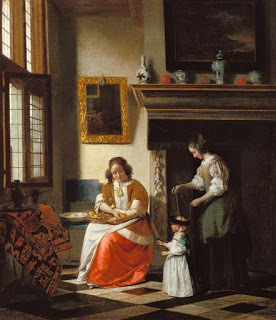 By Pieter de Hooch (1629–after 1684) - http://www.mdbk.de/sammlungen/details...,
By Pieter de Hooch (1629–after 1684) - http://www.mdbk.de/sammlungen/details...,
Public Domain, https://commons.wikimedia.org/w/index.php?curid=40616518
Leading StringsLeading strings were narrow strips of fabric or ribbons that were attached to children’s clothing and functioned as a sort of leash to keep the child upright while learning to walk and to keep them from straying too far.
Pudding CapsNote in this painting, the child is also wearing a pudding cap, a delightful name for a helmet-like hat that prevented head injuries should a child fall while learning to walk. It is thought that the term pudding cap came from the fear that if a child fell his brains might turn to mush or pudding—perhaps leading to the term “pudding head”?
In Will’s First Christmas, Darcy and Elizabeth take care to be sure the heir to Pemberley wears this quilted cotton, horsehair padded, leather lined, crash helmet. Elizabeth affixes the head guard, which is open at the top with a sausage-shaped padded roll that encircles Will’s head like a crown, and then she ties it securely under his chin with ribbons. (See photo.)
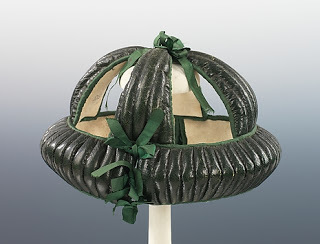 Source: Metropolitan Museum of ArtAccession Number 2009.300.1453
Source: Metropolitan Museum of ArtAccession Number 2009.300.1453
In the story, Jane and Bingley are the parents of identical twin boys. Jane and Elizabeth fasten walking strings to their sons’ shoulders to control the active little boys in the vast halls of Pemberley. I could hardly bear to write of this undignified action as it brought back all my feelings of toddler mortification.
Forced to wear a leash at a vulnerable age, I still remember the humiliation of being treated like a pet dog. My mother would often take my baby sister and I shopping. The stores in our little town were old-fashioned shops with open display counters on top and storage compartments below. Being a mischievous little imp, I devised a fun game. While my mother was preoccupied with her shopping list, I would quietly slide open a storage cabinet door and slip inside, sliding the door closed.
I would muffle my giggles as she called for me. A salesclerk or two would soon join her in hunt. Those delicious moments of pulling a successful prank were heavenly, but would all too soon end in discovery. It was after a series of vanishing acts that the awful pink harness and leash appeared. My mother would buckle the straps across my chest, clip the leash to the harness, and hold the end as if I were a dog. I distinctly remember mumbling toddler cuss words as I was forced to march down the street in harness.
The painting brought back that feeling of being trapped! Tied like a little puppet. Thank goodness leading strings have gone the way of the dodo. However, as a child, I would have welcomed pudding knee-guards as well as the cap.
About the Author Barbara Silkstone’s Amazon Author’s pagehttp://www.amazon.com/Barbara-Silkstone/e/B0047L8A8W
Barbara Silkstone’s Amazon Author’s pagehttp://www.amazon.com/Barbara-Silkstone/e/B0047L8A8W
Barbara Silkstone is the author of over thirty novels and novellas. She has currently written over fifteen Pride & Prejudice variations both Regency and Contemporary—always with a light comic touch.
Regency~Darcy and Elizabeth Will’s First Christmas – New Release http://amzn.to/2fjzVL6
Darcy and Elizabeth Serendipity – New Releasehttp://amzn.to/2f5yMHS
The Gallant Vicar and The Return of the Gallant Vicar, both tales of love rediscovered, featuring Darcy and Elizabeth, and a villain worse than Wickham.
Gallant Vicarhttp://amzn.to/1WE2LXm
Return of the Gallant Vicarhttp://amzn.to/1OBmuyu
The Witches of Longbourn ~ Three book series of magical comedies featuring Darcy, Elizabeth, and a Happily-Ever-After. http://amzn.to/2be6maT
Contemporary series of comedy mysteries ~
Barbara Silkstone is the author of the best selling Mister Darcy series of comedic mysteries ~ Eight books with more coming soon! http://amzn.to/1NVKlrnAll books are available in audio on Audible.com
I love hearing from my readers! You can reach me on FaceBook, Twitter, and at the Second Act Caféhttps://www.facebook.com/barbara.silkstone https://www.facebook.com/pages/Barbara-Silkstone-Author/156097004489447https://www.facebook.com/MisterDarcys... http://www.twitter.com/barbsilkstonehttp://secondactcafe.com/barbara-silkstone/
---oOo---
Have you ever encountered a painting that tugged at you emotionally? It might be a portrait or scene that holds a deeper meaning for you. In researching my latest book: Darcy and Elizabeth – Will’s First Christmas, a Regency Christmas variation, I came across this painting that shows a nurse teaching a child to walk using leading strings or a leash. I shuddered as it brought back a rush of memories and not from the 19th century!
 By Pieter de Hooch (1629–after 1684) - http://www.mdbk.de/sammlungen/details...,
By Pieter de Hooch (1629–after 1684) - http://www.mdbk.de/sammlungen/details..., Public Domain, https://commons.wikimedia.org/w/index.php?curid=40616518
Leading StringsLeading strings were narrow strips of fabric or ribbons that were attached to children’s clothing and functioned as a sort of leash to keep the child upright while learning to walk and to keep them from straying too far.
Pudding CapsNote in this painting, the child is also wearing a pudding cap, a delightful name for a helmet-like hat that prevented head injuries should a child fall while learning to walk. It is thought that the term pudding cap came from the fear that if a child fell his brains might turn to mush or pudding—perhaps leading to the term “pudding head”?
In Will’s First Christmas, Darcy and Elizabeth take care to be sure the heir to Pemberley wears this quilted cotton, horsehair padded, leather lined, crash helmet. Elizabeth affixes the head guard, which is open at the top with a sausage-shaped padded roll that encircles Will’s head like a crown, and then she ties it securely under his chin with ribbons. (See photo.)
 Source: Metropolitan Museum of ArtAccession Number 2009.300.1453
Source: Metropolitan Museum of ArtAccession Number 2009.300.1453In the story, Jane and Bingley are the parents of identical twin boys. Jane and Elizabeth fasten walking strings to their sons’ shoulders to control the active little boys in the vast halls of Pemberley. I could hardly bear to write of this undignified action as it brought back all my feelings of toddler mortification.
Forced to wear a leash at a vulnerable age, I still remember the humiliation of being treated like a pet dog. My mother would often take my baby sister and I shopping. The stores in our little town were old-fashioned shops with open display counters on top and storage compartments below. Being a mischievous little imp, I devised a fun game. While my mother was preoccupied with her shopping list, I would quietly slide open a storage cabinet door and slip inside, sliding the door closed.
I would muffle my giggles as she called for me. A salesclerk or two would soon join her in hunt. Those delicious moments of pulling a successful prank were heavenly, but would all too soon end in discovery. It was after a series of vanishing acts that the awful pink harness and leash appeared. My mother would buckle the straps across my chest, clip the leash to the harness, and hold the end as if I were a dog. I distinctly remember mumbling toddler cuss words as I was forced to march down the street in harness.
The painting brought back that feeling of being trapped! Tied like a little puppet. Thank goodness leading strings have gone the way of the dodo. However, as a child, I would have welcomed pudding knee-guards as well as the cap.
About the Author
 Barbara Silkstone’s Amazon Author’s pagehttp://www.amazon.com/Barbara-Silkstone/e/B0047L8A8W
Barbara Silkstone’s Amazon Author’s pagehttp://www.amazon.com/Barbara-Silkstone/e/B0047L8A8WBarbara Silkstone is the author of over thirty novels and novellas. She has currently written over fifteen Pride & Prejudice variations both Regency and Contemporary—always with a light comic touch.
Regency~Darcy and Elizabeth Will’s First Christmas – New Release http://amzn.to/2fjzVL6
Darcy and Elizabeth Serendipity – New Releasehttp://amzn.to/2f5yMHS
The Gallant Vicar and The Return of the Gallant Vicar, both tales of love rediscovered, featuring Darcy and Elizabeth, and a villain worse than Wickham.

Gallant Vicarhttp://amzn.to/1WE2LXm
Return of the Gallant Vicarhttp://amzn.to/1OBmuyu
The Witches of Longbourn ~ Three book series of magical comedies featuring Darcy, Elizabeth, and a Happily-Ever-After. http://amzn.to/2be6maT
Contemporary series of comedy mysteries ~
Barbara Silkstone is the author of the best selling Mister Darcy series of comedic mysteries ~ Eight books with more coming soon! http://amzn.to/1NVKlrnAll books are available in audio on Audible.com

I love hearing from my readers! You can reach me on FaceBook, Twitter, and at the Second Act Caféhttps://www.facebook.com/barbara.silkstone https://www.facebook.com/pages/Barbara-Silkstone-Author/156097004489447https://www.facebook.com/MisterDarcys... http://www.twitter.com/barbsilkstonehttp://secondactcafe.com/barbara-silkstone/
Published on December 12, 2016 03:34
December 7, 2016
All Washed Up….
Bring out your dead and welcome Suzie Lennox, with a tale of bodysnatching!
---oOo---
All Washed Up….
The last thing that you’d want to happen if you were in the habit of providing anatomy schools with fresh cadavers was to be caught in the act of exhumation. Clever concealment of both your tools and the cadaver when you were leaving the churchyard was key. You did not want to upset the parishioners and ruin your chances of visiting a graveyard again, not when there could be money to be made. Bodies however can sometimes be difficult to hide in a hurry and history has left us with a few macabre stories of the unfortunate events to befall just some of the bodysnatchers that I have found during my research.

Imagine if you will, you've been digging and pulling and folding and stuffing a cadaver out of its coffin into a sack when you hear a noise not too far behind you. Grabbing your quarry you take flight, frantically looking for somewhere to stash your loot until the coast is clear and it's safe to retrieve it. Yes, there were safe houses. Houses where you stashed cadavers and distributed them in a more orderly fashion the following morning, but not all bodysnatchers were fortunate enough to have access to such luxuries.
As a general rule you improvised. Bodies were found stuffed in sacks tucked under hedges, stored under staircases or in unused outbuildings and even on occasion dung heaps. In Peterborough in 1830, the body of a young woman was found in a garden shed, the house being conveniently situated behind the cemetery. Upon further investigation, it was found that a doctor lived at the address. No doubt a handy location! There is also the case of Dr Lowry, ‘a notorious lifter’ who used his house as a site to store cadavers before they were shipped to Edinburgh. Lowry’s house ‘Homefield’ was based in Coldingham in the Scottish Borders, and it is said that a small window acted as means of getting the bodies in and out of the premises. This ‘Resurrection Window’ was just the right size to allow bodies to be passed through and subsequently stored away in a vault found under the floor of the room beyond.
But what about the more gruesome cases?
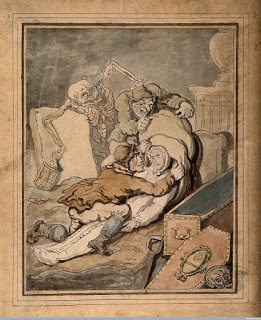
In 1793, long before the rise of the professional bodysnatcher, while students would still stalk graveyards at night acquiring their own subjects, a strange occurrence happened in a field near Battle Bridge, London. It happened on a Thursday. Limbs of all shapes and sizes were found strewn over the grass. Legs and arms of men, women and children, tossed into the field without a care in the world and for all to see. It is thought that it was the night-soil man’s fault. His round took in the cesspit of a number of ‘dissecting surgeons’ and after diligently going about his duty, he had emptied the contents of his cart in the said field without giving it a second thought. In 1821, ‘several human bodies with limbs lopped off’ were found mangled under some palisades on the Dover Road. Three females and one child’s body were found intact while a number of ‘hand, feet &c.’ had also been dumped. All were in a high state of decay. It was later concluded that the resurrection men had dumped the bodies and extremities to avoid detection, although they must have gone undetected for a number of weeks judging by the state of decay. No bodysnatcher would risk his freedom for a rotting body. Several months later Islington was ‘very much alarmed’ when the extremities of both men and women were found floating along the Regent’s Canal. As if this ghastly discovery was not enough, as the limbs were being collected by some local constables, out of the shadows appeared two well-dressed individuals brandishing a knife. Walking calmly over to the various off cuts, one of the men proceeded to hack at one of the limbs, cutting off one of the legs just below the knee. The obvious remonstrations ensued. It is thought that the bodies had been thrown in to the canal by the resurrection men, again hoping to avoid detection.
Floating bodies were not just found in London. Janet Sparks, a onetime parishioner of the parish of Torry, Aberdeenshire, died in 1808 and after being committed to the ground, was hastily removed that same night. Fearing detection, the bodysnatchers had quickly reburied Janet in the sandbanks of the Nigg Bay hoping to collect her body when things had died down. Unfortunately a violent storm blew up and the waves thrashed the sandbank where Janet was stored. Unable to return to get Janet’s body, she was left there to slowly decompose, finally washing up on the river bank opposite the church two months later.
As bodysnatching intensified, stealing a cadaver from a churchyard without being detected became more and more difficult. These are just a few of the methods that Britain’s resurrection men thought of to store cadavers, there are probably many more that we will never know about. Talk about having a skeleton in your cupboard!
Bio: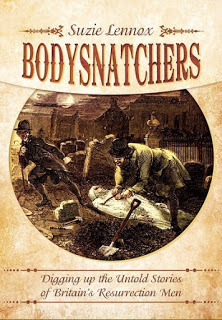 If you are interested in finding out more about Britain’s bodysnatchers, ‘Digging up the Untold Stories’ is now available to purchase to from Pen and Sword Books, AmazonUk , AmazonUS and all good bookshops.
If you are interested in finding out more about Britain’s bodysnatchers, ‘Digging up the Untold Stories’ is now available to purchase to from Pen and Sword Books, AmazonUk , AmazonUS and all good bookshops.
If you’re on twitter, you can follow Suzie at @Diggingup1800 or via Facebook or Suzie’s blog Britain’s Forgotten Bodysnatchers.
---oOo---
All Washed Up….
The last thing that you’d want to happen if you were in the habit of providing anatomy schools with fresh cadavers was to be caught in the act of exhumation. Clever concealment of both your tools and the cadaver when you were leaving the churchyard was key. You did not want to upset the parishioners and ruin your chances of visiting a graveyard again, not when there could be money to be made. Bodies however can sometimes be difficult to hide in a hurry and history has left us with a few macabre stories of the unfortunate events to befall just some of the bodysnatchers that I have found during my research.

Imagine if you will, you've been digging and pulling and folding and stuffing a cadaver out of its coffin into a sack when you hear a noise not too far behind you. Grabbing your quarry you take flight, frantically looking for somewhere to stash your loot until the coast is clear and it's safe to retrieve it. Yes, there were safe houses. Houses where you stashed cadavers and distributed them in a more orderly fashion the following morning, but not all bodysnatchers were fortunate enough to have access to such luxuries.
As a general rule you improvised. Bodies were found stuffed in sacks tucked under hedges, stored under staircases or in unused outbuildings and even on occasion dung heaps. In Peterborough in 1830, the body of a young woman was found in a garden shed, the house being conveniently situated behind the cemetery. Upon further investigation, it was found that a doctor lived at the address. No doubt a handy location! There is also the case of Dr Lowry, ‘a notorious lifter’ who used his house as a site to store cadavers before they were shipped to Edinburgh. Lowry’s house ‘Homefield’ was based in Coldingham in the Scottish Borders, and it is said that a small window acted as means of getting the bodies in and out of the premises. This ‘Resurrection Window’ was just the right size to allow bodies to be passed through and subsequently stored away in a vault found under the floor of the room beyond.
But what about the more gruesome cases?

In 1793, long before the rise of the professional bodysnatcher, while students would still stalk graveyards at night acquiring their own subjects, a strange occurrence happened in a field near Battle Bridge, London. It happened on a Thursday. Limbs of all shapes and sizes were found strewn over the grass. Legs and arms of men, women and children, tossed into the field without a care in the world and for all to see. It is thought that it was the night-soil man’s fault. His round took in the cesspit of a number of ‘dissecting surgeons’ and after diligently going about his duty, he had emptied the contents of his cart in the said field without giving it a second thought. In 1821, ‘several human bodies with limbs lopped off’ were found mangled under some palisades on the Dover Road. Three females and one child’s body were found intact while a number of ‘hand, feet &c.’ had also been dumped. All were in a high state of decay. It was later concluded that the resurrection men had dumped the bodies and extremities to avoid detection, although they must have gone undetected for a number of weeks judging by the state of decay. No bodysnatcher would risk his freedom for a rotting body. Several months later Islington was ‘very much alarmed’ when the extremities of both men and women were found floating along the Regent’s Canal. As if this ghastly discovery was not enough, as the limbs were being collected by some local constables, out of the shadows appeared two well-dressed individuals brandishing a knife. Walking calmly over to the various off cuts, one of the men proceeded to hack at one of the limbs, cutting off one of the legs just below the knee. The obvious remonstrations ensued. It is thought that the bodies had been thrown in to the canal by the resurrection men, again hoping to avoid detection.
Floating bodies were not just found in London. Janet Sparks, a onetime parishioner of the parish of Torry, Aberdeenshire, died in 1808 and after being committed to the ground, was hastily removed that same night. Fearing detection, the bodysnatchers had quickly reburied Janet in the sandbanks of the Nigg Bay hoping to collect her body when things had died down. Unfortunately a violent storm blew up and the waves thrashed the sandbank where Janet was stored. Unable to return to get Janet’s body, she was left there to slowly decompose, finally washing up on the river bank opposite the church two months later.
As bodysnatching intensified, stealing a cadaver from a churchyard without being detected became more and more difficult. These are just a few of the methods that Britain’s resurrection men thought of to store cadavers, there are probably many more that we will never know about. Talk about having a skeleton in your cupboard!
Bio:
 If you are interested in finding out more about Britain’s bodysnatchers, ‘Digging up the Untold Stories’ is now available to purchase to from Pen and Sword Books, AmazonUk , AmazonUS and all good bookshops.
If you are interested in finding out more about Britain’s bodysnatchers, ‘Digging up the Untold Stories’ is now available to purchase to from Pen and Sword Books, AmazonUk , AmazonUS and all good bookshops. If you’re on twitter, you can follow Suzie at @Diggingup1800 or via Facebook or Suzie’s blog Britain’s Forgotten Bodysnatchers.
Published on December 07, 2016 16:00
December 6, 2016
Secrets of the Parish Register
It's my pleasure to welcome Helen Barrell to the salon, to delve into some eye-opening tales form the parish register!
---oOo---
Parish registers aren’t only useful for genealogists. Often, you’ll find surprising notes in the margins. A baby born in a barn, a certificate for the King’s Evil, someone killed when the bell fell out of the steeple and crushed them. It was a note in the margin of a burial register about a victim of arsenic poisoning, which sparked my book Poison Panic. But maybe it’s thanks to Sharpe, or perhaps Mr Wickham, that one of my favourite parish register discoveries has to be the hundreds of soldiers, their wives and babies, who appear in the small Essex village of Weeley during the Napoleonic War. What on earth were they doing there?In 1803, when Napoleon’s sabre-rattling grew ever louder, it was felt that the north-east Essex coastline was dangerously undefended. Harwich, which had a Royal Navy presence, is just to the north of Weeley, and going west, there were docks and shipyards along the River Colne, and the garrison town of Colchester about 12 miles away. Martello towers were built along the coast, and several hundred soldiers were stationed in Weeley, ready in case the French ships appeared over the horizon.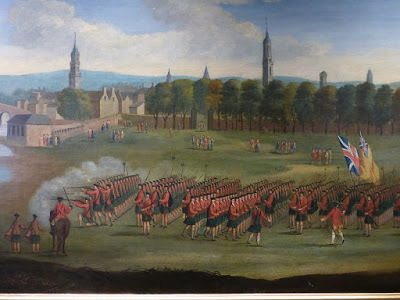
The first soldiers’ babies appear in the register in July 1803, the vicar carefully recording the father’s regiment or militia beside each entry. That same month, Mary Ann Grant, wife of Captain James Grant of the 42nd Regiment (better known as the Black Watch) wrote a letter to a friend from Weeley Camp. She described Weeley as ‘an insignificant village; but the encampment is large.’ She and James had married only a couple of months earlier, in Scotland. ‘I frequently accompany my dear G. to visit it; we have lodgings in the close vicinity,’ she explained.Life was genteel to start with - at least for officers’ wives like Mary Ann. The other wives would have been living at the Camp, but at least they could be with their husbands, unlike the wives who missed out on the ballots and couldn’t accompany their husbands when they were posted abroad. Mary Ann paid social calls, visiting the eccentric ‘Mr C’ (apparently Clarkson Cardinall in Tendring), and there was an entertainment at St Osyth Priory, then the home of the Nassaus. Mary Ann and her husband were posted to Scotland, but a few months later they were back in Weeley. The transformation was astonishing: ‘we found so complete a metamorphosis, that I doubted whether some enchantress had not been exerting her magical powers; it appeared hardly possible that in so short a space of time, as seven or eight weeks, barracks to contain five thousand men, could have sprung up by the hands of men; yet so it is.’ The field had disappeared, churned to mud under the feet of men and horses, and huts had been built to accommodate the soldiers and their families.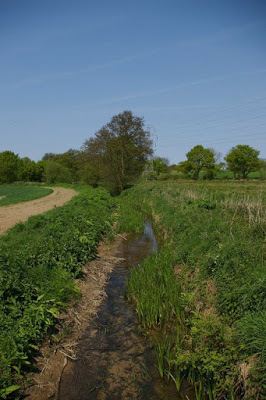 WeeleyThe Grants arrived in November. Water ran down the walls of their hut, and the mud was so bad that Mary had to be carried. ‘There is no way for a woman to venture out, but upon men’s shoulders, no very pleasant conveyance you must allow’: no mean feat when she was pregnant. Her husband urged her to find lodgings elsewhere, but ‘there are no lodgings to be had within two miles, and owing to the strict orders now issued for no officer to be absent from the barracks, in consequence of the prevailing idea of an invasion’ her husband had to stay in the Barracks. And Mary Ann was determined to remain with him; she ‘really cannot account for my feelings, when I say, that I am unable to persuade myself to leave G.’ It is hardly surprising that tragedy would not be far away in such poor conditions. The Grants’ baby died: whether it was stillborn or not, Mary Ann didn’t say, but their daughter doesn’t appear in Weeley’s parish register, or that of any nearby village. Mary Ann nearly died in childbirth. Her isolation is painful; on writing to a friend in February 1804, she said ‘many a time, amid all my sufferings did we wish for the skilful attendance of my dear aunt, and the soothing attention of my amiable young friend, who I am certain would have made a very tender nurse; but situated as we were, it was impossible we could request either of you to come.’ Trying to recover her health was difficult, stressed with the fear of invasion: ‘it is thought this coast will be the point, where the effort of landing will be made; what a scene of destruction would such an event occasion.’ The Grants were still living in a barrack hut at Weeley in June, but conditions had improved – or at least, Mary Ann put a brave face on it. ‘You would smile to see the ways and means we fall upon, to make the unpolished furniture allotted us, look neat; the roads are nicely made, and we have the comfort of walking dry, and enjoying a little society; our agreeable parties have again commenced; you would be amused were you to hear our invitations to each other; they are always accompanied by a desire, that each person will bring their camp-stool, knife, glass, &c.; such is the order among those who occupy barracks.’ Her next letter was written from Lexden Camp, on the other side of Colchester, but she made no more mention of huts, so it seems that she had at last found lodgings.
WeeleyThe Grants arrived in November. Water ran down the walls of their hut, and the mud was so bad that Mary had to be carried. ‘There is no way for a woman to venture out, but upon men’s shoulders, no very pleasant conveyance you must allow’: no mean feat when she was pregnant. Her husband urged her to find lodgings elsewhere, but ‘there are no lodgings to be had within two miles, and owing to the strict orders now issued for no officer to be absent from the barracks, in consequence of the prevailing idea of an invasion’ her husband had to stay in the Barracks. And Mary Ann was determined to remain with him; she ‘really cannot account for my feelings, when I say, that I am unable to persuade myself to leave G.’ It is hardly surprising that tragedy would not be far away in such poor conditions. The Grants’ baby died: whether it was stillborn or not, Mary Ann didn’t say, but their daughter doesn’t appear in Weeley’s parish register, or that of any nearby village. Mary Ann nearly died in childbirth. Her isolation is painful; on writing to a friend in February 1804, she said ‘many a time, amid all my sufferings did we wish for the skilful attendance of my dear aunt, and the soothing attention of my amiable young friend, who I am certain would have made a very tender nurse; but situated as we were, it was impossible we could request either of you to come.’ Trying to recover her health was difficult, stressed with the fear of invasion: ‘it is thought this coast will be the point, where the effort of landing will be made; what a scene of destruction would such an event occasion.’ The Grants were still living in a barrack hut at Weeley in June, but conditions had improved – or at least, Mary Ann put a brave face on it. ‘You would smile to see the ways and means we fall upon, to make the unpolished furniture allotted us, look neat; the roads are nicely made, and we have the comfort of walking dry, and enjoying a little society; our agreeable parties have again commenced; you would be amused were you to hear our invitations to each other; they are always accompanied by a desire, that each person will bring their camp-stool, knife, glass, &c.; such is the order among those who occupy barracks.’ Her next letter was written from Lexden Camp, on the other side of Colchester, but she made no more mention of huts, so it seems that she had at last found lodgings.
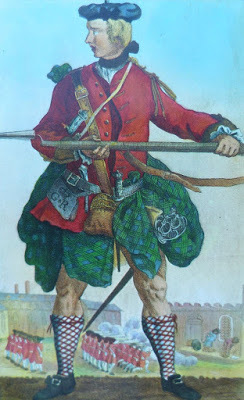 The Grants were a married couple when they arrived at Weeley, but there were plenty of single men among the thousands of soldiers who arrived in the village. It’s clear from the many Scottish names in the marriage register that soldiers and possibly soldiers’ widows were marrying in Weeley’s church. Some of the soldiers married local girls – for instance, Patrick McCrummen married Mary Simpson Baker from St Osyth, and William MacAmman married Susan Bradbrook from Thorp. One can hear Lydia Bennett’s shriek of ‘The militia!’ The burial register is similarly busy with late residents of the barracks, including victims of an outbreak of disease, and also Alexander McDonald, who was murdered by locals at a fair in Little Clacton.Once the threat of invasion had passed, the soldiers were moved on from Weeley. The barracks were dismantled, and all that’s left today is an empty field. It’s been said that if you pass through the field with a metal detector, you’ll find uniform buttons from obscure regiments of fencibles, which men joined before transferring to established army regiments. They just didn’t get around to changing their buttons, and at some point, the thread unravelled, and the button fell off their red jacket into the quagmire, lost for 200 years. And aside from the buttons that are periodically thrown up from the earth, there are all those names in the parish registers, to remind us of the thousands of people who once called the huts in Barrack Field home. Sources:The Story of Jaywick Martello Tower, by Essex County CouncilWeeley parish registers at the Essex Record OfficeGrant, Mary Ann. Sketches of Life and Manners with Delineations of Scenery in England, Scotland, and Ireland: interspersed with Moral Tales and Anecdotes, in original Letters: in two volumes. Vol. II. Second Edition, 1811. Printed by Cox, Son, and Baylis, London.Bio:
The Grants were a married couple when they arrived at Weeley, but there were plenty of single men among the thousands of soldiers who arrived in the village. It’s clear from the many Scottish names in the marriage register that soldiers and possibly soldiers’ widows were marrying in Weeley’s church. Some of the soldiers married local girls – for instance, Patrick McCrummen married Mary Simpson Baker from St Osyth, and William MacAmman married Susan Bradbrook from Thorp. One can hear Lydia Bennett’s shriek of ‘The militia!’ The burial register is similarly busy with late residents of the barracks, including victims of an outbreak of disease, and also Alexander McDonald, who was murdered by locals at a fair in Little Clacton.Once the threat of invasion had passed, the soldiers were moved on from Weeley. The barracks were dismantled, and all that’s left today is an empty field. It’s been said that if you pass through the field with a metal detector, you’ll find uniform buttons from obscure regiments of fencibles, which men joined before transferring to established army regiments. They just didn’t get around to changing their buttons, and at some point, the thread unravelled, and the button fell off their red jacket into the quagmire, lost for 200 years. And aside from the buttons that are periodically thrown up from the earth, there are all those names in the parish registers, to remind us of the thousands of people who once called the huts in Barrack Field home. Sources:The Story of Jaywick Martello Tower, by Essex County CouncilWeeley parish registers at the Essex Record OfficeGrant, Mary Ann. Sketches of Life and Manners with Delineations of Scenery in England, Scotland, and Ireland: interspersed with Moral Tales and Anecdotes, in original Letters: in two volumes. Vol. II. Second Edition, 1811. Printed by Cox, Son, and Baylis, London.Bio:
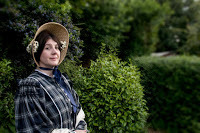 Helen Barrell’s Victorian true crime book Poison Panic: Arsenic Deaths in 1840s Essex is published by Pen & Sword [http://www.pen-and-sword.co.uk/Poison...] and is available from Waterstones [https://www.waterstones.com/book/pois...], Amazon [https://www.amazon.co.uk/Poison-Panic...], etc, in paperback and ebook. Fatal Evidence: Professor Alfred Swaine Taylor and the Dawn of Forensic Science will be published in July 2017. Helen has appeared on BBC Radio 4’s Punt PI, and has written for Fortean Times and Family Tree magazines. She guestblogs for Findmypast.
Helen Barrell’s Victorian true crime book Poison Panic: Arsenic Deaths in 1840s Essex is published by Pen & Sword [http://www.pen-and-sword.co.uk/Poison...] and is available from Waterstones [https://www.waterstones.com/book/pois...], Amazon [https://www.amazon.co.uk/Poison-Panic...], etc, in paperback and ebook. Fatal Evidence: Professor Alfred Swaine Taylor and the Dawn of Forensic Science will be published in July 2017. Helen has appeared on BBC Radio 4’s Punt PI, and has written for Fortean Times and Family Tree magazines. She guestblogs for Findmypast.
Genealogy and the not-so ordinary lives of ordinary people at , and Helen’s personal writing blog at www.helenbarrell.co.uk
---oOo---
Parish registers aren’t only useful for genealogists. Often, you’ll find surprising notes in the margins. A baby born in a barn, a certificate for the King’s Evil, someone killed when the bell fell out of the steeple and crushed them. It was a note in the margin of a burial register about a victim of arsenic poisoning, which sparked my book Poison Panic. But maybe it’s thanks to Sharpe, or perhaps Mr Wickham, that one of my favourite parish register discoveries has to be the hundreds of soldiers, their wives and babies, who appear in the small Essex village of Weeley during the Napoleonic War. What on earth were they doing there?In 1803, when Napoleon’s sabre-rattling grew ever louder, it was felt that the north-east Essex coastline was dangerously undefended. Harwich, which had a Royal Navy presence, is just to the north of Weeley, and going west, there were docks and shipyards along the River Colne, and the garrison town of Colchester about 12 miles away. Martello towers were built along the coast, and several hundred soldiers were stationed in Weeley, ready in case the French ships appeared over the horizon.

The first soldiers’ babies appear in the register in July 1803, the vicar carefully recording the father’s regiment or militia beside each entry. That same month, Mary Ann Grant, wife of Captain James Grant of the 42nd Regiment (better known as the Black Watch) wrote a letter to a friend from Weeley Camp. She described Weeley as ‘an insignificant village; but the encampment is large.’ She and James had married only a couple of months earlier, in Scotland. ‘I frequently accompany my dear G. to visit it; we have lodgings in the close vicinity,’ she explained.Life was genteel to start with - at least for officers’ wives like Mary Ann. The other wives would have been living at the Camp, but at least they could be with their husbands, unlike the wives who missed out on the ballots and couldn’t accompany their husbands when they were posted abroad. Mary Ann paid social calls, visiting the eccentric ‘Mr C’ (apparently Clarkson Cardinall in Tendring), and there was an entertainment at St Osyth Priory, then the home of the Nassaus. Mary Ann and her husband were posted to Scotland, but a few months later they were back in Weeley. The transformation was astonishing: ‘we found so complete a metamorphosis, that I doubted whether some enchantress had not been exerting her magical powers; it appeared hardly possible that in so short a space of time, as seven or eight weeks, barracks to contain five thousand men, could have sprung up by the hands of men; yet so it is.’ The field had disappeared, churned to mud under the feet of men and horses, and huts had been built to accommodate the soldiers and their families.
 WeeleyThe Grants arrived in November. Water ran down the walls of their hut, and the mud was so bad that Mary had to be carried. ‘There is no way for a woman to venture out, but upon men’s shoulders, no very pleasant conveyance you must allow’: no mean feat when she was pregnant. Her husband urged her to find lodgings elsewhere, but ‘there are no lodgings to be had within two miles, and owing to the strict orders now issued for no officer to be absent from the barracks, in consequence of the prevailing idea of an invasion’ her husband had to stay in the Barracks. And Mary Ann was determined to remain with him; she ‘really cannot account for my feelings, when I say, that I am unable to persuade myself to leave G.’ It is hardly surprising that tragedy would not be far away in such poor conditions. The Grants’ baby died: whether it was stillborn or not, Mary Ann didn’t say, but their daughter doesn’t appear in Weeley’s parish register, or that of any nearby village. Mary Ann nearly died in childbirth. Her isolation is painful; on writing to a friend in February 1804, she said ‘many a time, amid all my sufferings did we wish for the skilful attendance of my dear aunt, and the soothing attention of my amiable young friend, who I am certain would have made a very tender nurse; but situated as we were, it was impossible we could request either of you to come.’ Trying to recover her health was difficult, stressed with the fear of invasion: ‘it is thought this coast will be the point, where the effort of landing will be made; what a scene of destruction would such an event occasion.’ The Grants were still living in a barrack hut at Weeley in June, but conditions had improved – or at least, Mary Ann put a brave face on it. ‘You would smile to see the ways and means we fall upon, to make the unpolished furniture allotted us, look neat; the roads are nicely made, and we have the comfort of walking dry, and enjoying a little society; our agreeable parties have again commenced; you would be amused were you to hear our invitations to each other; they are always accompanied by a desire, that each person will bring their camp-stool, knife, glass, &c.; such is the order among those who occupy barracks.’ Her next letter was written from Lexden Camp, on the other side of Colchester, but she made no more mention of huts, so it seems that she had at last found lodgings.
WeeleyThe Grants arrived in November. Water ran down the walls of their hut, and the mud was so bad that Mary had to be carried. ‘There is no way for a woman to venture out, but upon men’s shoulders, no very pleasant conveyance you must allow’: no mean feat when she was pregnant. Her husband urged her to find lodgings elsewhere, but ‘there are no lodgings to be had within two miles, and owing to the strict orders now issued for no officer to be absent from the barracks, in consequence of the prevailing idea of an invasion’ her husband had to stay in the Barracks. And Mary Ann was determined to remain with him; she ‘really cannot account for my feelings, when I say, that I am unable to persuade myself to leave G.’ It is hardly surprising that tragedy would not be far away in such poor conditions. The Grants’ baby died: whether it was stillborn or not, Mary Ann didn’t say, but their daughter doesn’t appear in Weeley’s parish register, or that of any nearby village. Mary Ann nearly died in childbirth. Her isolation is painful; on writing to a friend in February 1804, she said ‘many a time, amid all my sufferings did we wish for the skilful attendance of my dear aunt, and the soothing attention of my amiable young friend, who I am certain would have made a very tender nurse; but situated as we were, it was impossible we could request either of you to come.’ Trying to recover her health was difficult, stressed with the fear of invasion: ‘it is thought this coast will be the point, where the effort of landing will be made; what a scene of destruction would such an event occasion.’ The Grants were still living in a barrack hut at Weeley in June, but conditions had improved – or at least, Mary Ann put a brave face on it. ‘You would smile to see the ways and means we fall upon, to make the unpolished furniture allotted us, look neat; the roads are nicely made, and we have the comfort of walking dry, and enjoying a little society; our agreeable parties have again commenced; you would be amused were you to hear our invitations to each other; they are always accompanied by a desire, that each person will bring their camp-stool, knife, glass, &c.; such is the order among those who occupy barracks.’ Her next letter was written from Lexden Camp, on the other side of Colchester, but she made no more mention of huts, so it seems that she had at last found lodgings.
 The Grants were a married couple when they arrived at Weeley, but there were plenty of single men among the thousands of soldiers who arrived in the village. It’s clear from the many Scottish names in the marriage register that soldiers and possibly soldiers’ widows were marrying in Weeley’s church. Some of the soldiers married local girls – for instance, Patrick McCrummen married Mary Simpson Baker from St Osyth, and William MacAmman married Susan Bradbrook from Thorp. One can hear Lydia Bennett’s shriek of ‘The militia!’ The burial register is similarly busy with late residents of the barracks, including victims of an outbreak of disease, and also Alexander McDonald, who was murdered by locals at a fair in Little Clacton.Once the threat of invasion had passed, the soldiers were moved on from Weeley. The barracks were dismantled, and all that’s left today is an empty field. It’s been said that if you pass through the field with a metal detector, you’ll find uniform buttons from obscure regiments of fencibles, which men joined before transferring to established army regiments. They just didn’t get around to changing their buttons, and at some point, the thread unravelled, and the button fell off their red jacket into the quagmire, lost for 200 years. And aside from the buttons that are periodically thrown up from the earth, there are all those names in the parish registers, to remind us of the thousands of people who once called the huts in Barrack Field home. Sources:The Story of Jaywick Martello Tower, by Essex County CouncilWeeley parish registers at the Essex Record OfficeGrant, Mary Ann. Sketches of Life and Manners with Delineations of Scenery in England, Scotland, and Ireland: interspersed with Moral Tales and Anecdotes, in original Letters: in two volumes. Vol. II. Second Edition, 1811. Printed by Cox, Son, and Baylis, London.Bio:
The Grants were a married couple when they arrived at Weeley, but there were plenty of single men among the thousands of soldiers who arrived in the village. It’s clear from the many Scottish names in the marriage register that soldiers and possibly soldiers’ widows were marrying in Weeley’s church. Some of the soldiers married local girls – for instance, Patrick McCrummen married Mary Simpson Baker from St Osyth, and William MacAmman married Susan Bradbrook from Thorp. One can hear Lydia Bennett’s shriek of ‘The militia!’ The burial register is similarly busy with late residents of the barracks, including victims of an outbreak of disease, and also Alexander McDonald, who was murdered by locals at a fair in Little Clacton.Once the threat of invasion had passed, the soldiers were moved on from Weeley. The barracks were dismantled, and all that’s left today is an empty field. It’s been said that if you pass through the field with a metal detector, you’ll find uniform buttons from obscure regiments of fencibles, which men joined before transferring to established army regiments. They just didn’t get around to changing their buttons, and at some point, the thread unravelled, and the button fell off their red jacket into the quagmire, lost for 200 years. And aside from the buttons that are periodically thrown up from the earth, there are all those names in the parish registers, to remind us of the thousands of people who once called the huts in Barrack Field home. Sources:The Story of Jaywick Martello Tower, by Essex County CouncilWeeley parish registers at the Essex Record OfficeGrant, Mary Ann. Sketches of Life and Manners with Delineations of Scenery in England, Scotland, and Ireland: interspersed with Moral Tales and Anecdotes, in original Letters: in two volumes. Vol. II. Second Edition, 1811. Printed by Cox, Son, and Baylis, London.Bio:  Helen Barrell’s Victorian true crime book Poison Panic: Arsenic Deaths in 1840s Essex is published by Pen & Sword [http://www.pen-and-sword.co.uk/Poison...] and is available from Waterstones [https://www.waterstones.com/book/pois...], Amazon [https://www.amazon.co.uk/Poison-Panic...], etc, in paperback and ebook. Fatal Evidence: Professor Alfred Swaine Taylor and the Dawn of Forensic Science will be published in July 2017. Helen has appeared on BBC Radio 4’s Punt PI, and has written for Fortean Times and Family Tree magazines. She guestblogs for Findmypast.
Helen Barrell’s Victorian true crime book Poison Panic: Arsenic Deaths in 1840s Essex is published by Pen & Sword [http://www.pen-and-sword.co.uk/Poison...] and is available from Waterstones [https://www.waterstones.com/book/pois...], Amazon [https://www.amazon.co.uk/Poison-Panic...], etc, in paperback and ebook. Fatal Evidence: Professor Alfred Swaine Taylor and the Dawn of Forensic Science will be published in July 2017. Helen has appeared on BBC Radio 4’s Punt PI, and has written for Fortean Times and Family Tree magazines. She guestblogs for Findmypast. Genealogy and the not-so ordinary lives of ordinary people at , and Helen’s personal writing blog at www.helenbarrell.co.uk
Published on December 06, 2016 16:00
December 5, 2016
A less than charming prospect?
It's a pleasure to welcome David Lassman, author of The Circle of Sappho, to delve into the dark side of regency Bath.
---oOo---
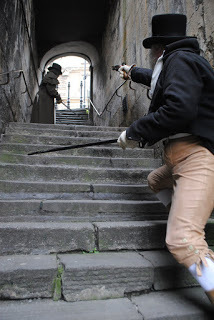 Courtest Terence James Although Jane Austen is acknowledged as one of the greatest writers English literature has ever produced, she is not without her critics. One of the main accusations leveled at her though, is not concerned about what she actually wrote, but rather what she left out. The main subject for these detractors being the Napoleonic Wars, which raged throughout Europe during the majority of Jane’s writing life and ended not long before her death. To read her writing though, you would not know they even existed. The same is true of the darker side of Regency Bath; the city she visited in the late 1790s, the place she was resident during the opening years of the nineteenth century and the main location for two of her novels; Northanger Abbey and Persuasion. For the characters of these two works, and for the author herself, Bath seemed a pleasure ground of immeasurable capacity. A place the rich, famous and elite, followed not far behind by the emerging middle classes, chose to spend a good part of their year; indulging in all kind of social engagements, while at the same time, for the most part, taking the waters in order to improve their health. Bath has been termed the Las Vegas of its day, but even in this American Mecca to gambling, there lay a sinister underbelly to its glitzy façade. The man who ‘founded’ it, Bugsy Siegal, for example, was assassinated in his own home by a gunman; the identity of which remains unknown to this day, although it is strongly suspected the mafia were behind the hiring of the killer.
Courtest Terence James Although Jane Austen is acknowledged as one of the greatest writers English literature has ever produced, she is not without her critics. One of the main accusations leveled at her though, is not concerned about what she actually wrote, but rather what she left out. The main subject for these detractors being the Napoleonic Wars, which raged throughout Europe during the majority of Jane’s writing life and ended not long before her death. To read her writing though, you would not know they even existed. The same is true of the darker side of Regency Bath; the city she visited in the late 1790s, the place she was resident during the opening years of the nineteenth century and the main location for two of her novels; Northanger Abbey and Persuasion. For the characters of these two works, and for the author herself, Bath seemed a pleasure ground of immeasurable capacity. A place the rich, famous and elite, followed not far behind by the emerging middle classes, chose to spend a good part of their year; indulging in all kind of social engagements, while at the same time, for the most part, taking the waters in order to improve their health. Bath has been termed the Las Vegas of its day, but even in this American Mecca to gambling, there lay a sinister underbelly to its glitzy façade. The man who ‘founded’ it, Bugsy Siegal, for example, was assassinated in his own home by a gunman; the identity of which remains unknown to this day, although it is strongly suspected the mafia were behind the hiring of the killer.
And like Las Vegas, Bath had a dark side, full of disreputable elements; an area where the characters of Jane’s novels or acquaintances in her actual life would fear to tread. It was known as the Avon Street district – although the locals merely knew it as ‘The Hate’ – and it was located in the south of the city, near the river which gave it its name.
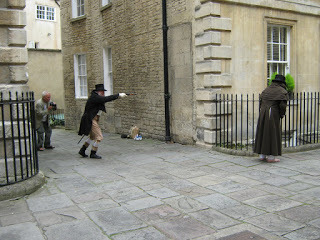
At the beginning of the eighteenth century, royalty, in the shape of Queen Anne, came to Bath to take the waters – the mineral waters were heralded to contain properties that could ward off all kind of ailments – and with a royal seal of approval the city began a period of expansion and popularity it has never really lost. In the years that followed the royal visits, as the elite followed suit, a city that for the most part remained firmly entrenched within its medieval walls and attitude found itself at the centre of an architectural explosion rarely seen in history, resulting in a city the envy of the whole of Europe. In practical terms, this meant development outwards from the medieval city in all directions. The east saw various parades built, the west gained a number of magnificent squares, and to the north were erected the crowning architectural achievements of the King’s Circus and the Royal Crescent. In the south of the city, however, it was a different story. With its close proximity to the river, this southern area was for all intents and purposes situated on a flood plain; ideally suited for pastoral grazing for the months the land was not under water, but totally incongruous for building on. In a climate of unbridled greed and ever increasing demand for accommodation, however, it did not take long before plans were being made for elegant and fashionable lodging houses on the land, with only the flimsiest attempt at flood prevention.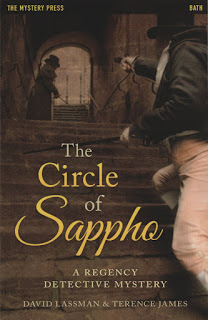 Once built and after the inevitable flooding happened, the houses swiftly ceased to be acceptable as dwelling-places to the upper and middle class visitors they were intended to attract. As the buildings became uninhabitable to all but the poorest of occupants, the whole district, named after the largest street within it, Avon Street, became ever more dilapidated and synonymous with the criminal element. Because along with the poor, destitute and immigrants, came thieves, pick-pockets and brothel-keepers, as well as all kinds of undesirables with nefarious occupations. And it was into this setting, the beginning of the nineteenth century, that myself and a co-writer, Terence James, decided to set a fictional detective. Known as The Regency Detective, reflecting the period it is set in, our main character, Jack Swann, finds himself having to frequently enter the Avon Street district’s foreboding warren of passages and alleyways during the investigations he undertakes.
Once built and after the inevitable flooding happened, the houses swiftly ceased to be acceptable as dwelling-places to the upper and middle class visitors they were intended to attract. As the buildings became uninhabitable to all but the poorest of occupants, the whole district, named after the largest street within it, Avon Street, became ever more dilapidated and synonymous with the criminal element. Because along with the poor, destitute and immigrants, came thieves, pick-pockets and brothel-keepers, as well as all kinds of undesirables with nefarious occupations. And it was into this setting, the beginning of the nineteenth century, that myself and a co-writer, Terence James, decided to set a fictional detective. Known as The Regency Detective, reflecting the period it is set in, our main character, Jack Swann, finds himself having to frequently enter the Avon Street district’s foreboding warren of passages and alleyways during the investigations he undertakes.
Swann’s back story is such that he is able to move easily between the two worlds which existed in nineteenth century Bath – the Austenesque ‘world’, which we probably know best through the television adaptations of her two ‘Bath’ novels (as well as the books themselves) and this darker, more notorious side that perhaps not unsurprisingly was never mentioned in city guide books.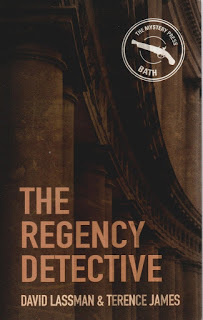 Whether Jane Austen ever visited Avon Street district is not known, although it would seem unlikely given its reputation, while the nearest readers ever get to it through her writing is within Persuasion. It is in this book that she placed Mrs. Smith, a former tutor of Anne Elliot, in lodgings in Westgate Street; and although the address is outside the district’s boundaries, it is still only a stone’s throw from the northern end of Avon Street. The Avon Street district retained its salubrious and dangerous reputation throughout the Victorian age – the suitably titled Avon Street, by Paul Emmanuelle, is set in the city during this time – and well into the twentieth century, when it was known as the city’s main red light district in the post-war years. The majority of the area, however, was eventually demolished during the infamous Sack of Bath of the 1960s and 1970s and for many residents the phrase ‘good riddance’ was no doubt uttered. Yet although it may now be gone, it should not be forgotten, for whenever one thinks of Jane Austen’s Bath, one should always remember that there are two sides to every story, even if one of those sides (outside the confines of fiction) now resides in the dark shadowy recesses of history.
Whether Jane Austen ever visited Avon Street district is not known, although it would seem unlikely given its reputation, while the nearest readers ever get to it through her writing is within Persuasion. It is in this book that she placed Mrs. Smith, a former tutor of Anne Elliot, in lodgings in Westgate Street; and although the address is outside the district’s boundaries, it is still only a stone’s throw from the northern end of Avon Street. The Avon Street district retained its salubrious and dangerous reputation throughout the Victorian age – the suitably titled Avon Street, by Paul Emmanuelle, is set in the city during this time – and well into the twentieth century, when it was known as the city’s main red light district in the post-war years. The majority of the area, however, was eventually demolished during the infamous Sack of Bath of the 1960s and 1970s and for many residents the phrase ‘good riddance’ was no doubt uttered. Yet although it may now be gone, it should not be forgotten, for whenever one thinks of Jane Austen’s Bath, one should always remember that there are two sides to every story, even if one of those sides (outside the confines of fiction) now resides in the dark shadowy recesses of history.

The Regency Detective series was created and written by David Lassman and Terence James and is published by The History Press. The latest book in the series, The Circle of Sappho, was published in earlier this year.
---oOo---
 Courtest Terence James Although Jane Austen is acknowledged as one of the greatest writers English literature has ever produced, she is not without her critics. One of the main accusations leveled at her though, is not concerned about what she actually wrote, but rather what she left out. The main subject for these detractors being the Napoleonic Wars, which raged throughout Europe during the majority of Jane’s writing life and ended not long before her death. To read her writing though, you would not know they even existed. The same is true of the darker side of Regency Bath; the city she visited in the late 1790s, the place she was resident during the opening years of the nineteenth century and the main location for two of her novels; Northanger Abbey and Persuasion. For the characters of these two works, and for the author herself, Bath seemed a pleasure ground of immeasurable capacity. A place the rich, famous and elite, followed not far behind by the emerging middle classes, chose to spend a good part of their year; indulging in all kind of social engagements, while at the same time, for the most part, taking the waters in order to improve their health. Bath has been termed the Las Vegas of its day, but even in this American Mecca to gambling, there lay a sinister underbelly to its glitzy façade. The man who ‘founded’ it, Bugsy Siegal, for example, was assassinated in his own home by a gunman; the identity of which remains unknown to this day, although it is strongly suspected the mafia were behind the hiring of the killer.
Courtest Terence James Although Jane Austen is acknowledged as one of the greatest writers English literature has ever produced, she is not without her critics. One of the main accusations leveled at her though, is not concerned about what she actually wrote, but rather what she left out. The main subject for these detractors being the Napoleonic Wars, which raged throughout Europe during the majority of Jane’s writing life and ended not long before her death. To read her writing though, you would not know they even existed. The same is true of the darker side of Regency Bath; the city she visited in the late 1790s, the place she was resident during the opening years of the nineteenth century and the main location for two of her novels; Northanger Abbey and Persuasion. For the characters of these two works, and for the author herself, Bath seemed a pleasure ground of immeasurable capacity. A place the rich, famous and elite, followed not far behind by the emerging middle classes, chose to spend a good part of their year; indulging in all kind of social engagements, while at the same time, for the most part, taking the waters in order to improve their health. Bath has been termed the Las Vegas of its day, but even in this American Mecca to gambling, there lay a sinister underbelly to its glitzy façade. The man who ‘founded’ it, Bugsy Siegal, for example, was assassinated in his own home by a gunman; the identity of which remains unknown to this day, although it is strongly suspected the mafia were behind the hiring of the killer.And like Las Vegas, Bath had a dark side, full of disreputable elements; an area where the characters of Jane’s novels or acquaintances in her actual life would fear to tread. It was known as the Avon Street district – although the locals merely knew it as ‘The Hate’ – and it was located in the south of the city, near the river which gave it its name.

At the beginning of the eighteenth century, royalty, in the shape of Queen Anne, came to Bath to take the waters – the mineral waters were heralded to contain properties that could ward off all kind of ailments – and with a royal seal of approval the city began a period of expansion and popularity it has never really lost. In the years that followed the royal visits, as the elite followed suit, a city that for the most part remained firmly entrenched within its medieval walls and attitude found itself at the centre of an architectural explosion rarely seen in history, resulting in a city the envy of the whole of Europe. In practical terms, this meant development outwards from the medieval city in all directions. The east saw various parades built, the west gained a number of magnificent squares, and to the north were erected the crowning architectural achievements of the King’s Circus and the Royal Crescent. In the south of the city, however, it was a different story. With its close proximity to the river, this southern area was for all intents and purposes situated on a flood plain; ideally suited for pastoral grazing for the months the land was not under water, but totally incongruous for building on. In a climate of unbridled greed and ever increasing demand for accommodation, however, it did not take long before plans were being made for elegant and fashionable lodging houses on the land, with only the flimsiest attempt at flood prevention.
 Once built and after the inevitable flooding happened, the houses swiftly ceased to be acceptable as dwelling-places to the upper and middle class visitors they were intended to attract. As the buildings became uninhabitable to all but the poorest of occupants, the whole district, named after the largest street within it, Avon Street, became ever more dilapidated and synonymous with the criminal element. Because along with the poor, destitute and immigrants, came thieves, pick-pockets and brothel-keepers, as well as all kinds of undesirables with nefarious occupations. And it was into this setting, the beginning of the nineteenth century, that myself and a co-writer, Terence James, decided to set a fictional detective. Known as The Regency Detective, reflecting the period it is set in, our main character, Jack Swann, finds himself having to frequently enter the Avon Street district’s foreboding warren of passages and alleyways during the investigations he undertakes.
Once built and after the inevitable flooding happened, the houses swiftly ceased to be acceptable as dwelling-places to the upper and middle class visitors they were intended to attract. As the buildings became uninhabitable to all but the poorest of occupants, the whole district, named after the largest street within it, Avon Street, became ever more dilapidated and synonymous with the criminal element. Because along with the poor, destitute and immigrants, came thieves, pick-pockets and brothel-keepers, as well as all kinds of undesirables with nefarious occupations. And it was into this setting, the beginning of the nineteenth century, that myself and a co-writer, Terence James, decided to set a fictional detective. Known as The Regency Detective, reflecting the period it is set in, our main character, Jack Swann, finds himself having to frequently enter the Avon Street district’s foreboding warren of passages and alleyways during the investigations he undertakes. Swann’s back story is such that he is able to move easily between the two worlds which existed in nineteenth century Bath – the Austenesque ‘world’, which we probably know best through the television adaptations of her two ‘Bath’ novels (as well as the books themselves) and this darker, more notorious side that perhaps not unsurprisingly was never mentioned in city guide books.
 Whether Jane Austen ever visited Avon Street district is not known, although it would seem unlikely given its reputation, while the nearest readers ever get to it through her writing is within Persuasion. It is in this book that she placed Mrs. Smith, a former tutor of Anne Elliot, in lodgings in Westgate Street; and although the address is outside the district’s boundaries, it is still only a stone’s throw from the northern end of Avon Street. The Avon Street district retained its salubrious and dangerous reputation throughout the Victorian age – the suitably titled Avon Street, by Paul Emmanuelle, is set in the city during this time – and well into the twentieth century, when it was known as the city’s main red light district in the post-war years. The majority of the area, however, was eventually demolished during the infamous Sack of Bath of the 1960s and 1970s and for many residents the phrase ‘good riddance’ was no doubt uttered. Yet although it may now be gone, it should not be forgotten, for whenever one thinks of Jane Austen’s Bath, one should always remember that there are two sides to every story, even if one of those sides (outside the confines of fiction) now resides in the dark shadowy recesses of history.
Whether Jane Austen ever visited Avon Street district is not known, although it would seem unlikely given its reputation, while the nearest readers ever get to it through her writing is within Persuasion. It is in this book that she placed Mrs. Smith, a former tutor of Anne Elliot, in lodgings in Westgate Street; and although the address is outside the district’s boundaries, it is still only a stone’s throw from the northern end of Avon Street. The Avon Street district retained its salubrious and dangerous reputation throughout the Victorian age – the suitably titled Avon Street, by Paul Emmanuelle, is set in the city during this time – and well into the twentieth century, when it was known as the city’s main red light district in the post-war years. The majority of the area, however, was eventually demolished during the infamous Sack of Bath of the 1960s and 1970s and for many residents the phrase ‘good riddance’ was no doubt uttered. Yet although it may now be gone, it should not be forgotten, for whenever one thinks of Jane Austen’s Bath, one should always remember that there are two sides to every story, even if one of those sides (outside the confines of fiction) now resides in the dark shadowy recesses of history.

The Regency Detective series was created and written by David Lassman and Terence James and is published by The History Press. The latest book in the series, The Circle of Sappho, was published in earlier this year.
Published on December 05, 2016 16:00
November 30, 2016
The Lost Story of the William & Mary
Today we gad out to sea with the marvellous Gill Hoffs, for a tale of shipwreck.
---oOo---
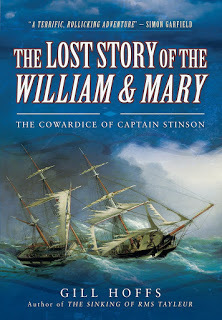
The lost story of the William & Mary happened after the long 18th century, the usual focus for this blog, but stories from the sea have something timeless about them so it is fitting that this tale of wretched rogues and angelic wreckers has found a home here. There are sharks and whales swimming out there as you read this piece which were alive while two hundred would-be emigrants fought for their lives in the Bahamas in 1853, and sadly the sea is just as deadly as it’s ever been for the unlucky and unwise.
The English, Irish, Scottish and Dutch emigrants were so hopeful as they boarded the ship in Liverpool, England, looking forward to new lives in America where some planned to settle a town in Wisconsin and others were meeting family members already established in the comparatively enormous country. They were the first passengers to travel on this ship and, it turned out, the last. After a horrendous journey with no ship surgeon, precious few provisions doled out by a violent crew, and a prescription of bacon from the captain for passengers dying of fever, the emigrants were relieved to reach the Bahamas as they knew the American port of New Orleans would soon be in sight. Unfortunately, the arrogant and inexperienced captain would take them no further. Map of route through Bahamas - Lotgevallen van den heer O.H.Bonnema, 1853, used with kind permission of Collectie Tresoar.One evening, having already narrowly missed a collision with an island, the ship was holed twice and began to sink. Captain Stinson threatened the passengers with his own desertion, told them the water in the hold was twice as deep as it really was, hid the distress flag, and eventually managed to sneak off with many of his crew (and the remaining provisions) in a lifeboat. Several of the passengers swam after them only to be murdered with a hatchet when they reached the fleeing sailors, and the cowardly captain stood with his hat held high and called over to the screaming families, “Friends, may you fare well”.
Map of route through Bahamas - Lotgevallen van den heer O.H.Bonnema, 1853, used with kind permission of Collectie Tresoar.One evening, having already narrowly missed a collision with an island, the ship was holed twice and began to sink. Captain Stinson threatened the passengers with his own desertion, told them the water in the hold was twice as deep as it really was, hid the distress flag, and eventually managed to sneak off with many of his crew (and the remaining provisions) in a lifeboat. Several of the passengers swam after them only to be murdered with a hatchet when they reached the fleeing sailors, and the cowardly captain stood with his hat held high and called over to the screaming families, “Friends, may you fare well”.
 William and Mary - Lotgevallen van den heer O.H.Bonnema, 1853, used with kind permission of Collectie Tresoar.He reported the ship as lost before his eyes and everyone aboard was presumed drowned. Journalists suspected something was up and pressed for answers only to find the captain had disappeared, as had his crew. Some weeks later the truth emerged and his disappearance made more sense. The people he left to drown had instead kept the pumps going for two days and nights until an exceptionally brave local wrecker and his crew came to the rescue.
William and Mary - Lotgevallen van den heer O.H.Bonnema, 1853, used with kind permission of Collectie Tresoar.He reported the ship as lost before his eyes and everyone aboard was presumed drowned. Journalists suspected something was up and pressed for answers only to find the captain had disappeared, as had his crew. Some weeks later the truth emerged and his disappearance made more sense. The people he left to drown had instead kept the pumps going for two days and nights until an exceptionally brave local wrecker and his crew came to the rescue.
To find out more, read “The Lost Story of the William & Mary: The Cowardice of Captain Stinson” (Pen & Sword, 2016).
About the Author
Gill Hoffs is the author of “Wild: a collection” (Pure Slush, 2012) and two shipwreck books, “The Sinking of RMS Tayleur: The Lost Story of the ‘Victorian Titanic’” (Pen & Sword, 2014, 2015) and the recently released “The Lost Story of the William & Mary: The Cowardice of Captain Stinson” (Pen & Sword, 2016). She lives in Warrington, England, with Coraline Cat. If anyone has any information regarding these shipwrecks and the people involved, they can email her at gillhoffs@hotmail.co.uk or find her on twitter @GillHoffs.
http://www.pen-and-sword.co.uk/The-Lost-Story-of-the-William-and-Mary-Hardback/p/12290http://www.pen-and-sword.co.uk/The-Sinking-of-RMS-Tayleur-Paperback/p/10677https://www.amazon.co.uk/Wild-collection-Gill-Hoffs-ebook/dp/B00DQ1A8UC
https://twitter.com/GillHoffs
---oOo---

The lost story of the William & Mary happened after the long 18th century, the usual focus for this blog, but stories from the sea have something timeless about them so it is fitting that this tale of wretched rogues and angelic wreckers has found a home here. There are sharks and whales swimming out there as you read this piece which were alive while two hundred would-be emigrants fought for their lives in the Bahamas in 1853, and sadly the sea is just as deadly as it’s ever been for the unlucky and unwise.

The English, Irish, Scottish and Dutch emigrants were so hopeful as they boarded the ship in Liverpool, England, looking forward to new lives in America where some planned to settle a town in Wisconsin and others were meeting family members already established in the comparatively enormous country. They were the first passengers to travel on this ship and, it turned out, the last. After a horrendous journey with no ship surgeon, precious few provisions doled out by a violent crew, and a prescription of bacon from the captain for passengers dying of fever, the emigrants were relieved to reach the Bahamas as they knew the American port of New Orleans would soon be in sight. Unfortunately, the arrogant and inexperienced captain would take them no further.
 Map of route through Bahamas - Lotgevallen van den heer O.H.Bonnema, 1853, used with kind permission of Collectie Tresoar.One evening, having already narrowly missed a collision with an island, the ship was holed twice and began to sink. Captain Stinson threatened the passengers with his own desertion, told them the water in the hold was twice as deep as it really was, hid the distress flag, and eventually managed to sneak off with many of his crew (and the remaining provisions) in a lifeboat. Several of the passengers swam after them only to be murdered with a hatchet when they reached the fleeing sailors, and the cowardly captain stood with his hat held high and called over to the screaming families, “Friends, may you fare well”.
Map of route through Bahamas - Lotgevallen van den heer O.H.Bonnema, 1853, used with kind permission of Collectie Tresoar.One evening, having already narrowly missed a collision with an island, the ship was holed twice and began to sink. Captain Stinson threatened the passengers with his own desertion, told them the water in the hold was twice as deep as it really was, hid the distress flag, and eventually managed to sneak off with many of his crew (and the remaining provisions) in a lifeboat. Several of the passengers swam after them only to be murdered with a hatchet when they reached the fleeing sailors, and the cowardly captain stood with his hat held high and called over to the screaming families, “Friends, may you fare well”.
 William and Mary - Lotgevallen van den heer O.H.Bonnema, 1853, used with kind permission of Collectie Tresoar.He reported the ship as lost before his eyes and everyone aboard was presumed drowned. Journalists suspected something was up and pressed for answers only to find the captain had disappeared, as had his crew. Some weeks later the truth emerged and his disappearance made more sense. The people he left to drown had instead kept the pumps going for two days and nights until an exceptionally brave local wrecker and his crew came to the rescue.
William and Mary - Lotgevallen van den heer O.H.Bonnema, 1853, used with kind permission of Collectie Tresoar.He reported the ship as lost before his eyes and everyone aboard was presumed drowned. Journalists suspected something was up and pressed for answers only to find the captain had disappeared, as had his crew. Some weeks later the truth emerged and his disappearance made more sense. The people he left to drown had instead kept the pumps going for two days and nights until an exceptionally brave local wrecker and his crew came to the rescue.To find out more, read “The Lost Story of the William & Mary: The Cowardice of Captain Stinson” (Pen & Sword, 2016).
About the Author
Gill Hoffs is the author of “Wild: a collection” (Pure Slush, 2012) and two shipwreck books, “The Sinking of RMS Tayleur: The Lost Story of the ‘Victorian Titanic’” (Pen & Sword, 2014, 2015) and the recently released “The Lost Story of the William & Mary: The Cowardice of Captain Stinson” (Pen & Sword, 2016). She lives in Warrington, England, with Coraline Cat. If anyone has any information regarding these shipwrecks and the people involved, they can email her at gillhoffs@hotmail.co.uk or find her on twitter @GillHoffs.
http://www.pen-and-sword.co.uk/The-Lost-Story-of-the-William-and-Mary-Hardback/p/12290http://www.pen-and-sword.co.uk/The-Sinking-of-RMS-Tayleur-Paperback/p/10677https://www.amazon.co.uk/Wild-collection-Gill-Hoffs-ebook/dp/B00DQ1A8UC
https://twitter.com/GillHoffs
Published on November 30, 2016 16:00
November 28, 2016
‘Bringing down the Flowers’: Abortion in Eighteenth-Century Britain
It's my pleasure to welcome the marvellous Kate Lister to the salon with an investigation into abortion in 18th century England.
---oOo---
‘Bringing down the Flowers’: Abortion in Eighteenth-Century BritainKate Lister‘But, th’aged Neurse calling her to her bower had gathered Rew and Savine and the flower of Camphora, and Callamint, and Dill’.William Buchan’s Domestic Medicine (1769) was a hugely popular work; it sold over 80,000 copies, was translated into several European languages and was republished to receptive audiences until the nineteenth century. In it, Buchan endeavours to ‘assist the well-meant endeavours in reliving distress; to eradicate dangerous and hurtful prejudices; to guard the credulous and ignorance against frauds and the impositions and quacks and imposters’. In his chapters on pregnancy, Buchan outlines the causes and dangers of abortion. In the eighteenth century ‘abortion’ was used interchangeably with ‘miscarriage’, and did not necessarily mean the deliberate termination of a pregnancy. However, in a footnote to his opening paragraph on miscarriage, Buchan makes a short, pointed acknowledgement that some women did seek a termination to their pregnancy. Every mother who procures an abortion does it at the hazard of her life; yet there are not a few who run this risk merely to prevent the trouble of bearing and bringing up children. It is surely a most unnatural crime, and cannot, even in the most abandoned, be viewed without horror; but in the decent matron, it is still more unpardonable. Those wretches who daily advertise their assistance to women, in this business, deserve in any opinion, the most severe of all human punishments.Abortion was not made illegal in Britain until 1803, when the passing of the Lord Ellenborough's Act made abortion after ‘the quickening’ (first movement of the of the foetus) punishable by death or transportation. Abortion before the quickening was not regarding as a criminal act as most theologians and physicians agreed this was when ensoulment of the child occurred. Until this occurred, the woman was not regarded as carrying child. But abortion post-quickening was regarded as deeply immoral. John Astruc called ‘miserable women’ seeking an abortion an ‘utter shame to human nature and religion’; Martin Madan called the women who died through botched abortions ‘doubly guilty of suicide and child murder, and a spouse procuring pills to induce an abortion is cited as suitable grounds for divorce in a number of eighteenth-century divorce trials.By the eighteen hundreds, rudimentary contraceptives were available, ranging from folklore and quackery to methods that would have offered limited protection. The withdrawal method is a time honoured (if completely unreliable) option. Animal-gut condoms, that were rinsed out and reused, had been available from the sixteenth century. In his memoirs Casanova records using a linen condom and a lemon slice as a cervical cap. Post-coital vaginal douching has been used as a method to wash away semen in the hopes of preventing pregnancy since the middle ages. Owing to widespread disease, malnutrition and poor health, fertility rates would have been reduced, but unwanted pregnancies were still widespread. When a girl found herself with a ‘bellyful’, pressures of shame, circumstance, poverty and myriad other reasons could lead her to seek a termination.It may not have been illegal, but abortion (post quickening) was certainly considered a deeply shameful act; consequently, the practice is shrouded in obscurity. Owing to the paucity of primary evidence, researching the history of abortion is notoriously difficult; the bulk of evidence left comes to us in court records when a woman has died from a botched abortion, and passing references in medical texts that acknowledge and swiftly condemn the practice. There are no texts that categorically state how to perform an abortion, or what herbs and tonics should be taken to induce one. However, euphemistic language is employed in herbal texts to allude to a plant’s abortive properties. A text may list plants that will induce miscarriage, but embed them within a warning of ‘not to be taken by pregnant women’. In much the same way as modern day ‘legal highs’ would advertise themselves as ‘research chemicals’ and ‘not for human consumption’ to get around the law. Advertisements for ‘women’s monthly pills’ and ‘cures’ for ‘menstrual blockage’ can be read as coded contraceptives and abortifacients. In English Sexualities (1990) Tim Hitchcock argued that Throughout the early-modern period recipes for medicines to ‘bring down the flowers’, or to regulate menstruation, were a common component of any herbal or recipe book, and could certainly be obtained from the local apothecary.Women seeking to ‘bring down the flowers’ would naturally progress from the least to the most dangerous methods of abortion. Certain known herbs were ingested; the most commonly known being savin, pennyroyal, rue and ergot. Savin, a species of juniper used to flavour gin (‘mother’s ruin’), is referenced in numerous court records regarding abortion once the practice was made illegal in 1803. In 1829, for example, Martha Barrett was accused of taking a ‘quantity of savin for the purpose of causing abortion’. In 1834, William Childs were charged with illegal abortion, having given Mary Jane Woolf ‘a large quantity of a certain drug, call savin…with intent thereby to cause and procure her miscarriage’. In 1855, William Longman was charged with ‘feloniously administering to Elizabeth Eldred Astins, 10 grains of a noxious thing called savin, with intent to pro cure miscarriage’. The list goes on. Abortifacient such as savin and pennyroyal are indeed toxic, and consumed at a high enough quantity could induce miscarriage; at too high a dose, they could, and did, kill the mother as well. If these methods proved ineffective (as would usually be the case), the mother was left with increasingly desperate and dangerous methods of abortion. Sitting in scalding hot baths, drinking vast quantities of gin, falling down stairs or being forcefully struck in the stomach have all been recorded as efforts to induce an abortion; but, if all these failed, surgical intervention could be sought. Accounts of surgical abortion are extraordinarily rare in the eighteenth century. One of the only detailed accounts of eighteenth-century surgical abortion is the record of the trial of Eleanor Beare of Derby in 1732. Eleanor was indicted on three accounts; one account of encouraging a man to murder his wife and two accounts of ‘destroying the foetus in the womb’, by ‘putting an iron instrument’ into the body; one of these women was ‘unknown to the jury’ and the other was Grace Belfort. Grace Belfort worked briefly for Eleanor, during which time she was raped by a visitor to the house. Grace confessed to Eleanor that she feared she was with child and for 30 shillings (paid by the rapist) Eleanor say she could ‘clear’ her of the child. The account given of what happened next is so rare, it is worth sharing in full; Evidence: Some company gave me Cyder and Brandy, my Mistress and I were both full of liquor, and when the company was gone, we could scarse get upstairs, but we did get up; then I laid me on the bed, and my mistress brought a kind of instrument, I took it to be like an iron skewer, and she put it up into my body a great way, and hurt me.Court: What followed upon that?Evidence: Some blood came from me.Court: Did you miscarry after that?Evidence: The next day… I had a miscarriage. Court: What did the prisoner do after this?Evidence: She told me the job was done.In 1760, poet Thomas Brown wrote ‘Satire Upon a Quack’, where he attacks an abortionist who ‘murdered’ his friend’s child. The poem is a bitter and sustained attack upon the ‘graveyard pimp’ who ‘unborn infants murder’d in the womb’. Brown curses the abortionist to hear ‘the screams of infants’ and their dying mothers for all eternity; to be the ‘jest of midwives’ and ‘strumpets without noses, and to be stalked by ‘the most solemn horrors of the night’. Brown makes reference to the abortionist’s tools throughout the poem; he does not mention an ‘iron skewer’ but he does allude to ‘baleful potions’, ‘stabbing verse’, ‘pointed darts’ and a ‘murdering quill’. Any thin, sharpened tool, even the sharpened point of a quill pen, would serve as a suitable ‘instrument’ to pierce the cervix and ‘bring down the flowers’. Of course, this procedure could be self-induced, or well-meaning friends or family members could attempt to penetrate the womb. How many women suffered irreparable damage, mutilation, infection and death as a result of this practice is not known; but many were willing to risk the dangers. If this method failed, or if the poor girl simply could not afford the abortionist fee; there were three options left; keep and raise the child, abandon the child, or murder the child and hide the body. In Francis Grose’s Lexicon Balatronicum: a Dictionary of Buckish Slang, University Wit, and Pickpocket Eloquence (1785), there is a truly disturbing entry; ‘To stifle a squeaker: to murder a bastard, or throw it into the necessary house (privy)’. This phrase also appears over hundred years earlier in A New Dictionary of the Terms Ancient and Modern of the Canting Crew (1698), and appears in various collections of slang through the nineteenth century. That infanticide had its own slang suggests that the practice was alarmingly common; that the slang is specifically referring to the disposal of illegitimate infants by burying them in the outhouse is the only remaining legacy of countless infants who shared this sad fate. Christian Russel, of the Parish of St. Pauls Covent Garden, was found guilty of murdering her illegitimate child in 1702 by ‘throwing the same into a House of Office’. In 1703, Mary Tudor was put on trial for her murdering her ‘female bastard child, on the 18th of January last, by throwing the same into a House of Office, whereby it was choked and strangled’. In 1708, Ann Gardner was found guilty of murdering her ‘female bastard…by throwing of it into a House of office, where 'twas suffocated with Filth’. Anne Wheeler was indicted for suffocating her ‘male bastard’ by ‘suffocating it in a house of easement’ in 1711. Elizabeth Arthur ‘drowned’ her ‘male bastard’ in a ‘house of office’ in 1717. Elizabeth Harrard was found guilty of drowning her ‘male bastard’ in 1739, and was one of four women to be hanged for murdering their illegitimate children that year. The list goes on and on. In the court records for the Old Bailey alone, between 1700 and 1800, there are no less than 134 trials for infanticide; the overwhelming majority of which are the killings of illegitimate children. We must remember that this is only one court, in one area and these trials are the ones that were caught. The actual figures of illegitimate infanticide will never be known, but most of the desperate women on trial were poor, unwed, unsupported and alone; they were desperate. Not all this trials resulted in a guilty verdict, and the mother’s life depended on being able to ‘prove’ that the child was stillborn. In 1624, parliament passed an act that made it a capital offense for unmarried mothers to conceal the death of an illegitimate child; the presumption being that if the child died, the mother had killed it. In order to prove that the birth was not concealed, the mother has to produce at least one witness statement that the baby was stillborn. The prosecution would also have to prove that the birth was deliberately concealed. Ann Gardner, mentioned above, was proven to have murdered her baby as she had made no provisions for the baby, and told no one she was pregnant.The Prisoner could say little in her Defence, it did not appear that she made any Provision for the Birth of the Child, nor was she heard to cry out, or us’d any endeavour to discover it, as the Statute of King James I [the 1624 Act] in such Cases requires. The Fact being clear, upon the whole the Jury found her Guilty of the Indictment.This was enough to condemn Ann to death; she was executed on 15th Jan 1708. When the London Foundling Hospital opened in 1739 by the philanthropist Thomas Coram, his primary aim was to give shelter to the children of the ‘unhappy female, who fell victim to the seductions and false promises of the designing man’, and had been left to ‘irretrievable disgrace’. When it first opened, the hospital expected to receive 20 infants, but was overwhelmed with demand. Eventually, the hospital had to limit admissions to infants under two months, and admittance was done through a ballot system. So that mothers could reclaim their child from the hospital, mothers were initially encouraged to leave a token with their baby, so they could be recognised later. The thousands of ribbons, thimbles, broken coins, lockets, buttons, pieces of paper and shells left with abandoned children are still housed at the Foundling Hospital today.
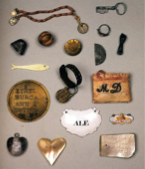 Photo: The Foundling Museum
Photo: The Foundling Museum
Of the 16,282 babies brought to the hospital between 1741 and 1760, only 152 were reclaimed. Today, most of us are privileged enough that we will never face a situation woman like Ann Gardner found themselves in over 300 years ago; destitute, ill, alone, stigmatised and pregnant with no maternity rights, medical care, security or means to raise a child. Although we have advanced far in 300 years, in terms of social security, medical care and attitudes to sex in general, the debate surrounding abortion are still rooted in religious moralising that seeks to demonise and punish the women who seek them and doctors who perform them. But, as the history of contraceptives shows, abortion will always be sought, risks will always be taken and no amount of criminalisation, not even the death penalty itself, will change that. In 1967, when the UK abortion act was passed, midwife Jennifer Worth was asked to comment on the morality of abortions; after 14 years of witnessing the reality of illegal abortion, she replied she ‘did not regard it as a moral issue, but as a medical issue. A minority of women will always want an abortion. Therefore, it must be done properly’.
Bibliography Buchan, William, Domestic Medicine (London: [n.pub.], 1769)Casanova, Giacomo, The memoirs of Jacques Casanova de Seingalt: Complete ([n.p.]: Simon and Schuster, 2013)Cruickshank, Dan, The secret history of Georgian London: How the wages of sin shaped the capital (London: Windmill Books, 2010)Harris, Karen, The medieval vagina: A historical and hysterical look at all things vaginal during the middle ages (London: Snark, 2014)Museum, Foundling, Foundling museum (Foundling Museum, 2016), <http://foundlingmuseum.org.uk/about/t... [accessed 2 September 2016]Online, Old Bailey Proceedings, Browse - central criminal court (2003), <https://www.oldbaileyonline.org/brows... [accessed 30 August 2016]---, Browse - central criminal court (2003), <https://www.oldbaileyonline.org/brows... [accessed 30 August 2016]Riddle, John M., Eve’s herbs: A history of contraception and abortion in the west (Cambridge, MA: Harvard University Press, 1999)The Tryal of Eleanore Beare of Derby, Gentleman’s Magazine 1732, pp. 933–934Trials for Adultery; Or, the History of Divorces, III vols, Trials for Adultery (London: [n.pub.], 1779)Worth, Jennifer, 'A deadly trade', The Guardian, 6 January 2005
About the AuthorDr Kate Lister, post doctoral research associate at Leeds Trinity University. Kate curates the Twitter feed @WhoresofYore and researches the history of sexuality.
http://leedstrinity.academia.edu/KateLister
Written content of this post copyright © Kate Lister, 2016.
 Photo: The Foundling Museum
Photo: The Foundling MuseumOf the 16,282 babies brought to the hospital between 1741 and 1760, only 152 were reclaimed. Today, most of us are privileged enough that we will never face a situation woman like Ann Gardner found themselves in over 300 years ago; destitute, ill, alone, stigmatised and pregnant with no maternity rights, medical care, security or means to raise a child. Although we have advanced far in 300 years, in terms of social security, medical care and attitudes to sex in general, the debate surrounding abortion are still rooted in religious moralising that seeks to demonise and punish the women who seek them and doctors who perform them. But, as the history of contraceptives shows, abortion will always be sought, risks will always be taken and no amount of criminalisation, not even the death penalty itself, will change that. In 1967, when the UK abortion act was passed, midwife Jennifer Worth was asked to comment on the morality of abortions; after 14 years of witnessing the reality of illegal abortion, she replied she ‘did not regard it as a moral issue, but as a medical issue. A minority of women will always want an abortion. Therefore, it must be done properly’.
Bibliography Buchan, William, Domestic Medicine (London: [n.pub.], 1769)Casanova, Giacomo, The memoirs of Jacques Casanova de Seingalt: Complete ([n.p.]: Simon and Schuster, 2013)Cruickshank, Dan, The secret history of Georgian London: How the wages of sin shaped the capital (London: Windmill Books, 2010)Harris, Karen, The medieval vagina: A historical and hysterical look at all things vaginal during the middle ages (London: Snark, 2014)Museum, Foundling, Foundling museum (Foundling Museum, 2016), <http://foundlingmuseum.org.uk/about/t... [accessed 2 September 2016]Online, Old Bailey Proceedings, Browse - central criminal court (2003), <https://www.oldbaileyonline.org/brows... [accessed 30 August 2016]---, Browse - central criminal court (2003), <https://www.oldbaileyonline.org/brows... [accessed 30 August 2016]Riddle, John M., Eve’s herbs: A history of contraception and abortion in the west (Cambridge, MA: Harvard University Press, 1999)The Tryal of Eleanore Beare of Derby, Gentleman’s Magazine 1732, pp. 933–934Trials for Adultery; Or, the History of Divorces, III vols, Trials for Adultery (London: [n.pub.], 1779)Worth, Jennifer, 'A deadly trade', The Guardian, 6 January 2005
About the AuthorDr Kate Lister, post doctoral research associate at Leeds Trinity University. Kate curates the Twitter feed @WhoresofYore and researches the history of sexuality.
http://leedstrinity.academia.edu/KateLister
Written content of this post copyright © Kate Lister, 2016.
Published on November 28, 2016 16:00
November 23, 2016
The Crown Spire
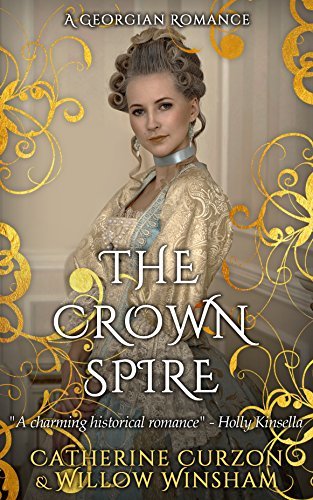 I am thrilled to announce that The Crown Spire, a rip-roaring adventure stuffed full of highwaymen, intrigue and romance, is now available to buy in ebook format across the world.
I am thrilled to announce that The Crown Spire, a rip-roaring adventure stuffed full of highwaymen, intrigue and romance, is now available to buy in ebook format across the world.Co-written by my good self and Willow Winsham, The Crown Spire takes readers back in time to 18th century Edinburgh and a world of bodysnatchers, brutish husbands and longed-for second chances.
Read on for an exclusive look at the first chapter!
Buy The Crown Spire at Amazon UK
Buy The Crown Spire at Amazon US
About The Crown Spire
Edinburgh, 1795
Alice Ingram escapes her brutish husband and leaves a glittering life in London far behind. With her niece, Beth, at her side she flees north, determined to save the girl from the fate she has endured but after an encounter with two mysterious highwaymen, life for the women will never be the same again...
Devoted to his daughter and resigned to a life of loneliness, James Dillingham has built a reputation as the finest physician in the land and a man for whom romance is a notion best avoided. He leaves all that to his best friend, Ed Hogan, who is just the sort of rogue to catch a girl's adventurous eye...
By day Alice finds herself ever more at odds with the straight-laced doctor who becomes her neighbour whilst by night, moonlit escapades with a masked highwayman lead her into a life of excitement in the shadow of the Crown Spire. Yet with her husband in relentless pursuit, are some shackles too strong to break?
Chapter 1
1795
Almost a week on the road, Alice Ingram reflected with a long sigh of exhaustion, leaning back against the squabs of the carriage. Almost a week crammed in together, feeling every bump, every pothole, counting the miles as they made their way northwards, each hour, each passing minute, taking them that one bit closer to freedom."It will be time to stop soon," she said simply to break the resentful silence, lifting her head as though to direct her niece’s attention to the window, "The light is fading.""Thank goodness!" Beth’s voice was full of relief and for once, Alice noted without humour, she and her fellow passenger were in agreement. For a moment Alice considered the wisdom of breaking for the night and peered at the darkening sky. They had covered a great deal of distance so far and now, with the end almost in sight, she found herself loathe to stop, to delay even one more night almost unbearable. "No," she shook her head, Beth letting out a huff of annoyance as Alice decided, "No, we shall press on."The trees on either side of the road, no thicker than two or three deep at the start of their journey that day, seemed too dark and entwined now, shadows in the dusk throwing darkness over the carriage where the bows reached out high above to make a vaulted chapel of the canopy. What was left of the daylight barely penetrated the new spring foliage, even the birdsong muted until the silence was unbroken by so much as the chirrup of a sparrow. Still the carriage rolled on towards its uncertain destination, the man at the reins no doubt looking forward to the next stop when he would hand over this party, trouble that they seemed to be, to another hired hand."It has been ages," Beth's pout grew to proportions not yet reached at the refusal, "My legs are so numb I can barely feel them and if I have to look at one more tree — Aunt Alice, please—" "Grace," Alice reminded her niece, "You must remember to call me aunt Grace now. There will be plenty of opportunity to stretch your legs when we reach Edinburgh. I told you - we carry on."The silence, seemingly so unbreakable, was shattered by the sound of a single gunshot, and a moment later the carriage veered from the road as the coachman fell from his seat, dead before he hit the ground. The horses surged on with the driverless carriage at their rumps, stopped only by two men who galloped alongside to grab up the reins and halt the progress of the vehicle."What -" Alice’s exclamation mingled with Beth's shriek of surprise as she fumbled for the weapon packed for just such an eventuality, heart pounding with fear.The doors on either side of the waylaid carriage were wrenched violently open before she was able to find the gun. What daylight remained was blocked by two hulking figures, pistols primed and ready. From beneath a beard thick as the tangled boughs outside a voice aged with alcohol and menace asked, "And what have we here?""I will shoot you," Alice felt surprisingly calm even as she was sure the appearance of their assailants was no coincidence. "Don't think for a moment I won't.""There'll be no shooting anybody," the man laughed, a scent of sweat and tobacco filling the stale air. He gestured into the carriage with his gun barrel and asked Beth, "You going to go along with my friend over there?""She will not be going anywhere." Uttering the words with a confidence she no longer felt, Alice heard the refusal echoed by the rigidly still young woman. The look of horror in her niece's eyes firmed her resolve as she added, "What do you want from us? If it is money you are after—""Money," the bandit laughed as his comrade moved further into the carriage, seizing Beth's wrist in a leather-gloved hand. "Who wants money when there's a fine bounty like you two?" With that he made his move, fist locking around Alice's arm and dragging her towards the door."No—" An attempt at resistance served only to lose her the weapon, though it was with savage satisfaction that she landed a hard kick to the shin of the man who had grabbed her. Despite his gasp of pain the triumph was short lived, as Alice found herself pulled from the carriage. She would not go, she knew, could not be parted from Beth, could not let the young woman suffer whatever tortures they had intended for her.Alice twisted and turned, fists and feet flying uselessly until her captor succeeded in pinioning her arms painfully behind her back. Even then she struggled and shouted for help, though where help could possibly come from, Alice did not know."Bitch!" The word was a hiss, the bandit wrapping one arm around her waist as he instructed the two men at the head of the carriage, "Empty the bags and bring the horses. Tonight, we’ll all of us have some fun!"Beth's scream rang in Alice’s ears as she was carried off, the smell and proximity of the man turning her stomach with fear of what was to come."And when you've done all that and finished with the lady," the bandit who had taken Beth's arm laughed, "You can have a go on this lass after I’m done!" With that, he dragged the screaming Beth out onto his horse, barely keeping hold of her as he galloped deep into the trees.
Published on November 23, 2016 16:00
November 22, 2016
Discovering Angelica Kauffman
Meet LL Diamond and the marvellous art of Angelica Kauffman!
---oOo---
Thank you so much for having me!
A few years ago, while working towards my art degree, I signed up for a class called Women in Art in Culture to fulfil a requirement towards my art history minor. I wasn’t certain what would be covered, but once the class began, I was fascinated by the strong and perservering women we studied. I still am and when I happen upon a painting by one of the wonderful artists, I tend to take a bit longer to admire the work of a woman who had to be immensely talented and willing to stand up to the social mores of the time to be recognised.
I even like to give a nod to a different artist when I write my novels by naming a modiste after a famous French artist such as Elizabeth Vigee-LeBrun, Madame Labille-Guiard, or Francoise Du Parc. A subtle nod and a small thing compared to their accomplishment, but just a bit of fun for me.
For today’s post, however, I decided to venture away from the French artists, and decided to share a quick overview of Angelica Kauffmann. I had never heard of her prior to the class, but each time I find a painting of hers in a National Trust house or a museum, I am reminded again of her incomparable talent.
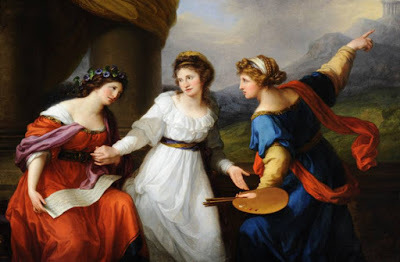 Angelica Kauffman
Angelica Kauffman
Joshua Reynolds, Thomas Gainsborough, and John Constable are probably more familiar the average art buff than Angelica Kauffmann, yet Kauffmann was incredibly talented and produced art during the same time period, bucking convention and painting what she wished rather than what was expected of her as a woman, making her a founding member of the British Royal Academy and a sought-after portraitist in London.
Women from the beginning had a difficult time making a name for themselves in the art world. After the Renaissance, the French Royal Academy established what they called the “Hierarchy of Genres,” which prioritized certain types of paintings over others and establishing an order of importance of subject matter. The Royal Academy deemed histories the highest since they dealt with great events in human history as well as religion followed by portraiture, genre paintings (scenes of every day life), landscape, and still life. Believe it or not, this also made it more difficult for women to become a successful artist because acceptable subjects for ladies (still life and animals) were low on the Hierarchy of Genres, not to mention many ladies used watercolour, which was not considered a medium by the establishment of the time—it was considered craft.
Angelica Kauffman was born in Switzerland in 1741 and was considered a child prodigy. Her father and painter Johann Joseph Kauffmann, whose work consisted of murals and portraits, trained Kauffmann as she travelled through Switzerland, Italy, and Austria as his assistant.
Kauffmann, however, began achieving recognition in her own right during a three-year stay in Italy when she began painting histories and portraits, earning her an election to Rome’s Accademia di San Luca at the age of twenty-three.
Kauffmann’s success in painting histories is part of what makes her so interesting. While Kauffman was said to have studied from classical statues, women were not allowed to attend life-drawing classes. These classes, which featured nude models and were strictly attended only by men, were thought to offend the sensibilities of a lady. For most, this restriction limited the artist’s training and for some, the ability to paint a history or a great portrait. Kauffmann didn’t allow this to limit her, and instead, focused her work mostly on female subjects from mythology and classical history.
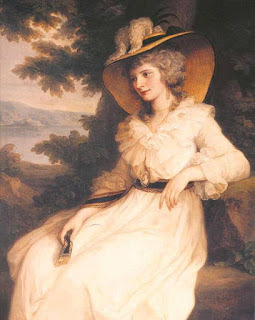 Portrait of Lady Foster
Portrait of Lady Foster
In 1766, Kauffmann moved to London where she gained popularity as a portrait painter to the aristocracy and also to a few royal patrons. During this time, Kauffmann and Mary Moser were the only two female artists among the founding members of the Royal Academy in London. The painting below, by Johann Zoffany, shows the founding members of the Royal Academy having a life-drawing session with two nude men as models. Note that Mary Moser and Angelica Kauffmann are not present among the men, but are depicted as paintings on the wall. Since the practice was not allowed in reality, they could not portray it in art, so two wonderful female artists are relegated to being works of art themselves.
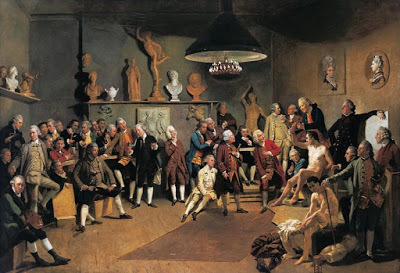 Portraits of the Academicians of the Royal Academy
Portraits of the Academicians of the Royal Academy
After a successful fifteen-year stay in London, Angelica Kauffmann returned to Italy with her husband, painter Antonio Zucchi. When she died in 1807, the famous sculptor Antonio Canova directed her funeral, basing it on the funeral of Raphael. A compliment indeed!
Just a few places I have found Angelica Kauffman paintings around England:
Lady Elizabeth Christiana Hervey (later Lady Bess Foster) by Angelica Kauffmann can be found at Ickworth in Suffolk.
Henrietta Laura Pulteney (1766-1808) can be found at the Holburne Museum in BathSaltram House in Devon has close to ten Kauffmann paintings including a portrait of Sir Joshua Reynolds and a number of histories (several are on the staircase used in Emma Thompson’s Sense and Sensibility), including Hector taking leave of Andromache and Ulysses discovering Achilles.
(http://www.nationaltrustcollections.org.uk/results?SearchTerms=kauffmann+saltram&Collections=4f90ad65fffffe0775b3e6f13748ab57&Sort=collection)
About the Author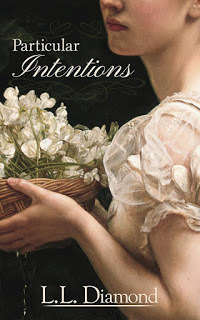
 L.L. Diamond is more commonly known as Leslie to her friends and Mom to her three kids. A native of Louisiana, she has spent the majority of her life living within an hour of New Orleans until she vowed to follow her husband to the ends of the earth as a military wife. Louisiana, Mississippi, California, Texas, New Mexico, Nebraska, and now England have all been called home along the way. After watching Sense and Sensibility with her mother, Leslie became a fan of Jane Austen, reading her collected works over the next few years. Pride and Prejudice stood out as a favorite and has dominated her writing since finding Jane Austen Fan Fiction.
L.L. Diamond is more commonly known as Leslie to her friends and Mom to her three kids. A native of Louisiana, she has spent the majority of her life living within an hour of New Orleans until she vowed to follow her husband to the ends of the earth as a military wife. Louisiana, Mississippi, California, Texas, New Mexico, Nebraska, and now England have all been called home along the way. After watching Sense and Sensibility with her mother, Leslie became a fan of Jane Austen, reading her collected works over the next few years. Pride and Prejudice stood out as a favorite and has dominated her writing since finding Jane Austen Fan Fiction.
Aside from mother and writer, Leslie considers herself a perpetual student. She has degrees in biology and studio art, but will devour any subject of interest simply for the knowledge. As an artist, her concentration is in graphic design, but watercolor is her medium of choice with one of her watercolors featured on the cover of her second book, A Matter of Chance. She is a member of the Jane Austen Society of North America. Leslie also plays flute and piano, but much like Elizabeth Bennet, she is always in need of practice! Leslie’s books include Rain and Retribution, A Matter of Chance, An Unwavering Trust, The Earl’s Conquest, and Particular Intentions.
Sources:https://nmwa.org/explore/artist-profi...http://www.npg.org.uk/collections/search/person/mp02473/angelica-kauffmannhttps://www.royalacademy.org.uk/artic...http://www.tate.org.uk/art/artists/angelica-kauffman-303
images from commons.wikimedia.org
---oOo---
Thank you so much for having me!
A few years ago, while working towards my art degree, I signed up for a class called Women in Art in Culture to fulfil a requirement towards my art history minor. I wasn’t certain what would be covered, but once the class began, I was fascinated by the strong and perservering women we studied. I still am and when I happen upon a painting by one of the wonderful artists, I tend to take a bit longer to admire the work of a woman who had to be immensely talented and willing to stand up to the social mores of the time to be recognised.
I even like to give a nod to a different artist when I write my novels by naming a modiste after a famous French artist such as Elizabeth Vigee-LeBrun, Madame Labille-Guiard, or Francoise Du Parc. A subtle nod and a small thing compared to their accomplishment, but just a bit of fun for me.
For today’s post, however, I decided to venture away from the French artists, and decided to share a quick overview of Angelica Kauffmann. I had never heard of her prior to the class, but each time I find a painting of hers in a National Trust house or a museum, I am reminded again of her incomparable talent.
 Angelica Kauffman
Angelica KauffmanJoshua Reynolds, Thomas Gainsborough, and John Constable are probably more familiar the average art buff than Angelica Kauffmann, yet Kauffmann was incredibly talented and produced art during the same time period, bucking convention and painting what she wished rather than what was expected of her as a woman, making her a founding member of the British Royal Academy and a sought-after portraitist in London.
Women from the beginning had a difficult time making a name for themselves in the art world. After the Renaissance, the French Royal Academy established what they called the “Hierarchy of Genres,” which prioritized certain types of paintings over others and establishing an order of importance of subject matter. The Royal Academy deemed histories the highest since they dealt with great events in human history as well as religion followed by portraiture, genre paintings (scenes of every day life), landscape, and still life. Believe it or not, this also made it more difficult for women to become a successful artist because acceptable subjects for ladies (still life and animals) were low on the Hierarchy of Genres, not to mention many ladies used watercolour, which was not considered a medium by the establishment of the time—it was considered craft.
Angelica Kauffman was born in Switzerland in 1741 and was considered a child prodigy. Her father and painter Johann Joseph Kauffmann, whose work consisted of murals and portraits, trained Kauffmann as she travelled through Switzerland, Italy, and Austria as his assistant.
Kauffmann, however, began achieving recognition in her own right during a three-year stay in Italy when she began painting histories and portraits, earning her an election to Rome’s Accademia di San Luca at the age of twenty-three.
Kauffmann’s success in painting histories is part of what makes her so interesting. While Kauffman was said to have studied from classical statues, women were not allowed to attend life-drawing classes. These classes, which featured nude models and were strictly attended only by men, were thought to offend the sensibilities of a lady. For most, this restriction limited the artist’s training and for some, the ability to paint a history or a great portrait. Kauffmann didn’t allow this to limit her, and instead, focused her work mostly on female subjects from mythology and classical history.
 Portrait of Lady Foster
Portrait of Lady FosterIn 1766, Kauffmann moved to London where she gained popularity as a portrait painter to the aristocracy and also to a few royal patrons. During this time, Kauffmann and Mary Moser were the only two female artists among the founding members of the Royal Academy in London. The painting below, by Johann Zoffany, shows the founding members of the Royal Academy having a life-drawing session with two nude men as models. Note that Mary Moser and Angelica Kauffmann are not present among the men, but are depicted as paintings on the wall. Since the practice was not allowed in reality, they could not portray it in art, so two wonderful female artists are relegated to being works of art themselves.
 Portraits of the Academicians of the Royal Academy
Portraits of the Academicians of the Royal AcademyAfter a successful fifteen-year stay in London, Angelica Kauffmann returned to Italy with her husband, painter Antonio Zucchi. When she died in 1807, the famous sculptor Antonio Canova directed her funeral, basing it on the funeral of Raphael. A compliment indeed!
Just a few places I have found Angelica Kauffman paintings around England:
Lady Elizabeth Christiana Hervey (later Lady Bess Foster) by Angelica Kauffmann can be found at Ickworth in Suffolk.
Henrietta Laura Pulteney (1766-1808) can be found at the Holburne Museum in BathSaltram House in Devon has close to ten Kauffmann paintings including a portrait of Sir Joshua Reynolds and a number of histories (several are on the staircase used in Emma Thompson’s Sense and Sensibility), including Hector taking leave of Andromache and Ulysses discovering Achilles.
(http://www.nationaltrustcollections.org.uk/results?SearchTerms=kauffmann+saltram&Collections=4f90ad65fffffe0775b3e6f13748ab57&Sort=collection)
About the Author

 L.L. Diamond is more commonly known as Leslie to her friends and Mom to her three kids. A native of Louisiana, she has spent the majority of her life living within an hour of New Orleans until she vowed to follow her husband to the ends of the earth as a military wife. Louisiana, Mississippi, California, Texas, New Mexico, Nebraska, and now England have all been called home along the way. After watching Sense and Sensibility with her mother, Leslie became a fan of Jane Austen, reading her collected works over the next few years. Pride and Prejudice stood out as a favorite and has dominated her writing since finding Jane Austen Fan Fiction.
L.L. Diamond is more commonly known as Leslie to her friends and Mom to her three kids. A native of Louisiana, she has spent the majority of her life living within an hour of New Orleans until she vowed to follow her husband to the ends of the earth as a military wife. Louisiana, Mississippi, California, Texas, New Mexico, Nebraska, and now England have all been called home along the way. After watching Sense and Sensibility with her mother, Leslie became a fan of Jane Austen, reading her collected works over the next few years. Pride and Prejudice stood out as a favorite and has dominated her writing since finding Jane Austen Fan Fiction. Aside from mother and writer, Leslie considers herself a perpetual student. She has degrees in biology and studio art, but will devour any subject of interest simply for the knowledge. As an artist, her concentration is in graphic design, but watercolor is her medium of choice with one of her watercolors featured on the cover of her second book, A Matter of Chance. She is a member of the Jane Austen Society of North America. Leslie also plays flute and piano, but much like Elizabeth Bennet, she is always in need of practice! Leslie’s books include Rain and Retribution, A Matter of Chance, An Unwavering Trust, The Earl’s Conquest, and Particular Intentions.
Sources:https://nmwa.org/explore/artist-profi...http://www.npg.org.uk/collections/search/person/mp02473/angelica-kauffmannhttps://www.royalacademy.org.uk/artic...http://www.tate.org.uk/art/artists/angelica-kauffman-303
images from commons.wikimedia.org
Published on November 22, 2016 16:00
November 21, 2016
Charity events in Georgian England, or, the poor shall be with us always
It's a pleasure to welcome the Bluestocking Belles to the salon once more!
---oOo---
Charity events in Georgian England or the poor shall be with us alwaysOur view of Georgian life is often coloured by fictional accounts of high society, where ladies spent vast amounts on bonnets and gentlemen gambled away entire estates on an evening’s card game. Which is a fair reflection of a small part of society, come to that. But one in ten families lived below the ‘breadline’, and at times as many as two in five. Many people were precariously balanced on a knife edge where illness, accidents or old age could tumble them into starvation.
The Poor Law and parish-based support The Poor Law was meant to make sure such unfortunates had the help they needed. Wealthy households paid a levy to the parish, and local overseers apportioned financial hand-outs, clothing and fuel, and bread to those who could prove they belonged to the parish and therefore had a right to its support. Where the parish authorities were genuinely charitable, poor relief might tide a family through a bad patch so they could get back on their feet. But the idea that poverty was a character fault is not a 21st Century invention. Strident voices wanted the poor to suffer for their charity handout.Workhouse to discourage the poor from seeking helpIN 1722, the first legislation passed allowing parishes to provide poor relief in specially built workhouses. By the end of the century, more than 100,000 people lived under their stringent and often dire regime.The sexes were segregated, and the able-bodied set to work, with strict rules and routines. Some workhouses were pleasant enough. Others were no better than prisons, and many of the poor preferred to starve rather than be put in the workhouse.They were overcrowded, and the people in them often overworked and underfed. Epidemics tore through them, and the deathrate for people of every age, and particularly for newborns, was brutal. Nearly 2,400 children were received into London workhouses in 1750. Fewer than 170 of those children were still alive in 1755.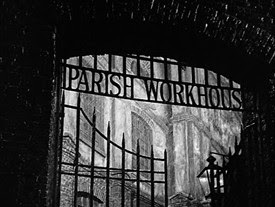
Private charitiesThe parish levy wasn’t the only funding for the poor, though. Many landowners (and particularly their wives) kept to the age-old tradition of providing food and other items to those who lived on or near their estates, and some continued this one-on-one help in town. They also joined groups to provide help for those who needed it.Private charities collected money for initiatives such as the Foundling Hospital in London, which cared for children whose mothers could not support them, the Marine Society, which trained poor boys for a life at sea, the Magdalen Hospital for Penitent Prostitues, various hospitals to provide free medical care, and educational initiatives. I particularly like the name of the Female Friendly Society for the Relief of Poor, Infirm, Aged Widows and Single Women of Good Character Who Have Seen Better Days. The days of 140 character tweets were well in the future.Benefits with friendsTo raise money, these charitable groups used the time honoured idea of offering tickets to an entertainment: balls, musical concerts, art exhibitions. Some charged a weekly subscription to support their work. Some solicited donations through pamphlets and direct approaches to possible donors. (Some people have suggested balls were a Victorian contrivance, but British newspapers contain advertisements for charity balls and assemblies, or reports on them, going back to the middle of the previous century.)Groups would also get together to raise money for a friend in need; perhaps someone who had been injured or widowed. In the British Newspapers Online archive, I found a number of advertisements for events ‘for the benefit of Mr. Xxx’, which is, of course, where we get our term Benefit, to mean a charity event.Women and charityWhile men ran many of the great philanthropic institutions, charity was “the proper public expression of a gentlewoman’s religious energy”. [Vickery, 254] Many women joined benevolent societies (where members agreed to provide support for any of their number who fell on hard times) and a huge number of women founded or joined charitable groups that supported what they themselves would have called ‘good works’.ReferencesPorter, Roy: English Society in the 18th Century. Penguin, 1982Uglow, Jenny: In These Times, Faber & Faber 2014Vickers, Amanda: The Gentleman’s Daughter, Yale, 1998White, Matthew: Poverty in Britain. https://www.bl.uk/georgian-britain/articles/poverty-in-georgian-britain
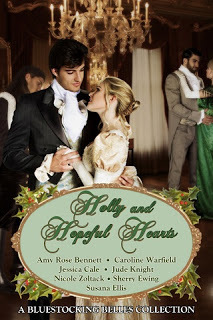 Holly and Hopeful HeartsWhen the Duchess of Haverford sends out invitations to a Yuletide house party and a New Year’s Eve ball at her country estate, Hollystone Hall, those who respond know that Her Grace intends to raise money for her favourite cause and promote whatever marriages she can. Eight assorted heroes and heroines set out with their pocketbooks firmly clutched and hearts in protective custody. Or are they?A Suitable Husband, by Jude KnightAs the Duchess of Haverford’s companion, Cedrica Grenford is not treated as a poor relation and is encouraged to mingle with Her Grace’s guests. Surely she can find a suitable husband amongst the gentlemen gathered for the duchess’s house party. Above stairs or possibly below. Valuing Vanessa, by Susana EllisFacing a dim future as a spinster under her mother’s thumb, Vanessa Sedgely makes a practical decision to attach an amiable gentleman who will not try to rule her life. A Kiss for Charity, by Sherry EwingYoung widow Grace, Lady de Courtenay, has no idea how a close encounter with a rake at a masquerade ball would make her yearn for love again. Can she learn to forgive Lord Nicholas Lacey and set aside their differences to let love into her heart?Artemis, by Jessica CaleActress Charlotte Halfpenny is in trouble. Pregnant, abandoned by her lover, and out of a job, Charlotte faces eviction two weeks before Christmas. When the reclusive Earl of Somerton makes her an outrageous offer, she has no choice but to accept. Could he be the man of her dreams, or is the nightmare just beginning?The Bluestocking and the Barbarian, by Jude KnightJames must marry to please his grandfather, the duke, and to win social acceptance for himself and his father’s other foreign-born children. But only Lady Sophia Belvoir makes his heart sing, and to win her he must invite himself to spend Christmas at the home of his father’s greatest enemy. Christmas Kisses, by Nicole ZoltackLouisa Wycliff, Dowager Countess of Exeter wants only for her darling daughter, Anna, to find a man she can love and marry. Appallingly, Anna has her sights on a scoundrel of a duke who chases after every skirt he sees. Anna truly thinks the dashing duke cares for her, but her mother has her doubts. An Open Heart, by Caroline WarfieldEsther Baumann longs for a loving husband who will help her create a home where they will teach their children to value the traditions of their people, but she wants a man who is also open to new ideas and happy to make friends outside their narrow circle. Is it so unreasonable to ask for toe curling passion as well?Dashing Through the Snow, by Amy Rose BennettHeadstrong bluestocking, Miss Kate Woodville, never thought her Christmas would be spent racing across England with a viscount hell-bent on vengeance. She certainly never expected to find love...Amazon US: http://ow.ly/INwa3049Ey3 Amazon UK: http://ow.ly/ZMuH3049ELM Amazon Australia: http://ow.ly/TczG3049EQ2
Holly and Hopeful HeartsWhen the Duchess of Haverford sends out invitations to a Yuletide house party and a New Year’s Eve ball at her country estate, Hollystone Hall, those who respond know that Her Grace intends to raise money for her favourite cause and promote whatever marriages she can. Eight assorted heroes and heroines set out with their pocketbooks firmly clutched and hearts in protective custody. Or are they?A Suitable Husband, by Jude KnightAs the Duchess of Haverford’s companion, Cedrica Grenford is not treated as a poor relation and is encouraged to mingle with Her Grace’s guests. Surely she can find a suitable husband amongst the gentlemen gathered for the duchess’s house party. Above stairs or possibly below. Valuing Vanessa, by Susana EllisFacing a dim future as a spinster under her mother’s thumb, Vanessa Sedgely makes a practical decision to attach an amiable gentleman who will not try to rule her life. A Kiss for Charity, by Sherry EwingYoung widow Grace, Lady de Courtenay, has no idea how a close encounter with a rake at a masquerade ball would make her yearn for love again. Can she learn to forgive Lord Nicholas Lacey and set aside their differences to let love into her heart?Artemis, by Jessica CaleActress Charlotte Halfpenny is in trouble. Pregnant, abandoned by her lover, and out of a job, Charlotte faces eviction two weeks before Christmas. When the reclusive Earl of Somerton makes her an outrageous offer, she has no choice but to accept. Could he be the man of her dreams, or is the nightmare just beginning?The Bluestocking and the Barbarian, by Jude KnightJames must marry to please his grandfather, the duke, and to win social acceptance for himself and his father’s other foreign-born children. But only Lady Sophia Belvoir makes his heart sing, and to win her he must invite himself to spend Christmas at the home of his father’s greatest enemy. Christmas Kisses, by Nicole ZoltackLouisa Wycliff, Dowager Countess of Exeter wants only for her darling daughter, Anna, to find a man she can love and marry. Appallingly, Anna has her sights on a scoundrel of a duke who chases after every skirt he sees. Anna truly thinks the dashing duke cares for her, but her mother has her doubts. An Open Heart, by Caroline WarfieldEsther Baumann longs for a loving husband who will help her create a home where they will teach their children to value the traditions of their people, but she wants a man who is also open to new ideas and happy to make friends outside their narrow circle. Is it so unreasonable to ask for toe curling passion as well?Dashing Through the Snow, by Amy Rose BennettHeadstrong bluestocking, Miss Kate Woodville, never thought her Christmas would be spent racing across England with a viscount hell-bent on vengeance. She certainly never expected to find love...Amazon US: http://ow.ly/INwa3049Ey3 Amazon UK: http://ow.ly/ZMuH3049ELM Amazon Australia: http://ow.ly/TczG3049EQ2
Amazon Canada: http://ow.ly/IERm3049EYM Smashwords: https://www.smashwords.com/books/view/664559 Kobo: http://ow.ly/Vx1n304jGzjBarnes & Noble: http://ow.ly/LqCI304jGuSiBooks: http://ow.ly/JcSI304jGWE The Bluestocking BellesThe Bluestocking Belles, the “BellesInBlue”, are seven very different writers united by a love of history and a history of writing about love. From sweet to steamy, from light-hearted fun to dark tortured tales full of angst, from London ballrooms to country cottages to the sultan’s seraglio, one or more of us will have a tale to suit all tastes and mood.
---oOo---
Charity events in Georgian England or the poor shall be with us alwaysOur view of Georgian life is often coloured by fictional accounts of high society, where ladies spent vast amounts on bonnets and gentlemen gambled away entire estates on an evening’s card game. Which is a fair reflection of a small part of society, come to that. But one in ten families lived below the ‘breadline’, and at times as many as two in five. Many people were precariously balanced on a knife edge where illness, accidents or old age could tumble them into starvation.

The Poor Law and parish-based support The Poor Law was meant to make sure such unfortunates had the help they needed. Wealthy households paid a levy to the parish, and local overseers apportioned financial hand-outs, clothing and fuel, and bread to those who could prove they belonged to the parish and therefore had a right to its support. Where the parish authorities were genuinely charitable, poor relief might tide a family through a bad patch so they could get back on their feet. But the idea that poverty was a character fault is not a 21st Century invention. Strident voices wanted the poor to suffer for their charity handout.Workhouse to discourage the poor from seeking helpIN 1722, the first legislation passed allowing parishes to provide poor relief in specially built workhouses. By the end of the century, more than 100,000 people lived under their stringent and often dire regime.The sexes were segregated, and the able-bodied set to work, with strict rules and routines. Some workhouses were pleasant enough. Others were no better than prisons, and many of the poor preferred to starve rather than be put in the workhouse.They were overcrowded, and the people in them often overworked and underfed. Epidemics tore through them, and the deathrate for people of every age, and particularly for newborns, was brutal. Nearly 2,400 children were received into London workhouses in 1750. Fewer than 170 of those children were still alive in 1755.

Private charitiesThe parish levy wasn’t the only funding for the poor, though. Many landowners (and particularly their wives) kept to the age-old tradition of providing food and other items to those who lived on or near their estates, and some continued this one-on-one help in town. They also joined groups to provide help for those who needed it.Private charities collected money for initiatives such as the Foundling Hospital in London, which cared for children whose mothers could not support them, the Marine Society, which trained poor boys for a life at sea, the Magdalen Hospital for Penitent Prostitues, various hospitals to provide free medical care, and educational initiatives. I particularly like the name of the Female Friendly Society for the Relief of Poor, Infirm, Aged Widows and Single Women of Good Character Who Have Seen Better Days. The days of 140 character tweets were well in the future.Benefits with friendsTo raise money, these charitable groups used the time honoured idea of offering tickets to an entertainment: balls, musical concerts, art exhibitions. Some charged a weekly subscription to support their work. Some solicited donations through pamphlets and direct approaches to possible donors. (Some people have suggested balls were a Victorian contrivance, but British newspapers contain advertisements for charity balls and assemblies, or reports on them, going back to the middle of the previous century.)Groups would also get together to raise money for a friend in need; perhaps someone who had been injured or widowed. In the British Newspapers Online archive, I found a number of advertisements for events ‘for the benefit of Mr. Xxx’, which is, of course, where we get our term Benefit, to mean a charity event.Women and charityWhile men ran many of the great philanthropic institutions, charity was “the proper public expression of a gentlewoman’s religious energy”. [Vickery, 254] Many women joined benevolent societies (where members agreed to provide support for any of their number who fell on hard times) and a huge number of women founded or joined charitable groups that supported what they themselves would have called ‘good works’.ReferencesPorter, Roy: English Society in the 18th Century. Penguin, 1982Uglow, Jenny: In These Times, Faber & Faber 2014Vickers, Amanda: The Gentleman’s Daughter, Yale, 1998White, Matthew: Poverty in Britain. https://www.bl.uk/georgian-britain/articles/poverty-in-georgian-britain
 Holly and Hopeful HeartsWhen the Duchess of Haverford sends out invitations to a Yuletide house party and a New Year’s Eve ball at her country estate, Hollystone Hall, those who respond know that Her Grace intends to raise money for her favourite cause and promote whatever marriages she can. Eight assorted heroes and heroines set out with their pocketbooks firmly clutched and hearts in protective custody. Or are they?A Suitable Husband, by Jude KnightAs the Duchess of Haverford’s companion, Cedrica Grenford is not treated as a poor relation and is encouraged to mingle with Her Grace’s guests. Surely she can find a suitable husband amongst the gentlemen gathered for the duchess’s house party. Above stairs or possibly below. Valuing Vanessa, by Susana EllisFacing a dim future as a spinster under her mother’s thumb, Vanessa Sedgely makes a practical decision to attach an amiable gentleman who will not try to rule her life. A Kiss for Charity, by Sherry EwingYoung widow Grace, Lady de Courtenay, has no idea how a close encounter with a rake at a masquerade ball would make her yearn for love again. Can she learn to forgive Lord Nicholas Lacey and set aside their differences to let love into her heart?Artemis, by Jessica CaleActress Charlotte Halfpenny is in trouble. Pregnant, abandoned by her lover, and out of a job, Charlotte faces eviction two weeks before Christmas. When the reclusive Earl of Somerton makes her an outrageous offer, she has no choice but to accept. Could he be the man of her dreams, or is the nightmare just beginning?The Bluestocking and the Barbarian, by Jude KnightJames must marry to please his grandfather, the duke, and to win social acceptance for himself and his father’s other foreign-born children. But only Lady Sophia Belvoir makes his heart sing, and to win her he must invite himself to spend Christmas at the home of his father’s greatest enemy. Christmas Kisses, by Nicole ZoltackLouisa Wycliff, Dowager Countess of Exeter wants only for her darling daughter, Anna, to find a man she can love and marry. Appallingly, Anna has her sights on a scoundrel of a duke who chases after every skirt he sees. Anna truly thinks the dashing duke cares for her, but her mother has her doubts. An Open Heart, by Caroline WarfieldEsther Baumann longs for a loving husband who will help her create a home where they will teach their children to value the traditions of their people, but she wants a man who is also open to new ideas and happy to make friends outside their narrow circle. Is it so unreasonable to ask for toe curling passion as well?Dashing Through the Snow, by Amy Rose BennettHeadstrong bluestocking, Miss Kate Woodville, never thought her Christmas would be spent racing across England with a viscount hell-bent on vengeance. She certainly never expected to find love...Amazon US: http://ow.ly/INwa3049Ey3 Amazon UK: http://ow.ly/ZMuH3049ELM Amazon Australia: http://ow.ly/TczG3049EQ2
Holly and Hopeful HeartsWhen the Duchess of Haverford sends out invitations to a Yuletide house party and a New Year’s Eve ball at her country estate, Hollystone Hall, those who respond know that Her Grace intends to raise money for her favourite cause and promote whatever marriages she can. Eight assorted heroes and heroines set out with their pocketbooks firmly clutched and hearts in protective custody. Or are they?A Suitable Husband, by Jude KnightAs the Duchess of Haverford’s companion, Cedrica Grenford is not treated as a poor relation and is encouraged to mingle with Her Grace’s guests. Surely she can find a suitable husband amongst the gentlemen gathered for the duchess’s house party. Above stairs or possibly below. Valuing Vanessa, by Susana EllisFacing a dim future as a spinster under her mother’s thumb, Vanessa Sedgely makes a practical decision to attach an amiable gentleman who will not try to rule her life. A Kiss for Charity, by Sherry EwingYoung widow Grace, Lady de Courtenay, has no idea how a close encounter with a rake at a masquerade ball would make her yearn for love again. Can she learn to forgive Lord Nicholas Lacey and set aside their differences to let love into her heart?Artemis, by Jessica CaleActress Charlotte Halfpenny is in trouble. Pregnant, abandoned by her lover, and out of a job, Charlotte faces eviction two weeks before Christmas. When the reclusive Earl of Somerton makes her an outrageous offer, she has no choice but to accept. Could he be the man of her dreams, or is the nightmare just beginning?The Bluestocking and the Barbarian, by Jude KnightJames must marry to please his grandfather, the duke, and to win social acceptance for himself and his father’s other foreign-born children. But only Lady Sophia Belvoir makes his heart sing, and to win her he must invite himself to spend Christmas at the home of his father’s greatest enemy. Christmas Kisses, by Nicole ZoltackLouisa Wycliff, Dowager Countess of Exeter wants only for her darling daughter, Anna, to find a man she can love and marry. Appallingly, Anna has her sights on a scoundrel of a duke who chases after every skirt he sees. Anna truly thinks the dashing duke cares for her, but her mother has her doubts. An Open Heart, by Caroline WarfieldEsther Baumann longs for a loving husband who will help her create a home where they will teach their children to value the traditions of their people, but she wants a man who is also open to new ideas and happy to make friends outside their narrow circle. Is it so unreasonable to ask for toe curling passion as well?Dashing Through the Snow, by Amy Rose BennettHeadstrong bluestocking, Miss Kate Woodville, never thought her Christmas would be spent racing across England with a viscount hell-bent on vengeance. She certainly never expected to find love...Amazon US: http://ow.ly/INwa3049Ey3 Amazon UK: http://ow.ly/ZMuH3049ELM Amazon Australia: http://ow.ly/TczG3049EQ2 Amazon Canada: http://ow.ly/IERm3049EYM Smashwords: https://www.smashwords.com/books/view/664559 Kobo: http://ow.ly/Vx1n304jGzjBarnes & Noble: http://ow.ly/LqCI304jGuSiBooks: http://ow.ly/JcSI304jGWE The Bluestocking BellesThe Bluestocking Belles, the “BellesInBlue”, are seven very different writers united by a love of history and a history of writing about love. From sweet to steamy, from light-hearted fun to dark tortured tales full of angst, from London ballrooms to country cottages to the sultan’s seraglio, one or more of us will have a tale to suit all tastes and mood.
Published on November 21, 2016 16:00



